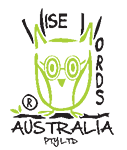-
Sale!
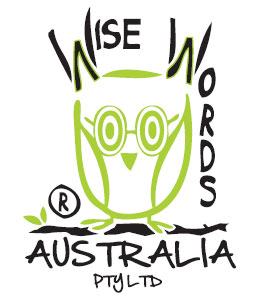 10% Discount Applied to Total Package (See individual programs for details and examples.) The Total Language Package includes both assessment tools and ALL programs at all 4 levels of understanding. Assessments The Wise Words Screening Tool The Wise Words Screening Advantage Level 1 Matching Objects Level 2 Functions Lotto Fish for Functions Naming Functions Sorting Functions Matching Functions Functions Board Games Semantic Naming Semantic Sorting Semantic Lotto Semantic Matching Semantic Families Semantic Board Games Two Characteristics Barrier games Level 3 Identifying Parts of a Whole and Exclusions (Levels 2 - 4) Identifying Similarities and Differences (Levels 2 - 3) Word Definitions Mind Map 1 Word Definitions Mind Map 2 Word Definitions Mind Map 3 What Will Happen Next? Selecting an Alternative Negatives and Exclusions Explaining Similarities Identifying Objects Used Together Level 4 Explaining the Logic of Compound Words Explaining an Inference Justifying a Decision Based on Characteristics Selecting the Means to a Goal Selecting a Tool Predicting Changes in Position Explaining the Reason for an Action The Wise Words Screening Tool provides range of questions/instructions representing all four levels of Blank’s model. It offers two questions/instructions at each level for each picture presented. Space is provided beneath these questions for the clinician/teacher to transcribe the child’s response. This simple screening tool can be used to plan goals for children and will monitor a child’s progress over time. The Wise Words Screening Advantage offers an assessment tool which can be administered quickly. The provided tables enable a teacher or clinician to analyse responses, devise goals and track a child’s progress over time. The screener consists of 10 colour stimulus pictures with a range of questions/instructions representing all four levels of Blank’s model. All (twenty nine) Wise Words Language programs are included in this package. These programs have been designed to support a child's language development from the early, concrete language of a younger child to the older child where the perceptual language distance has increased significantly and where language is used to problem solve and reason about materials and experiences. The Blank's levels are fluid and the Wise Words Programs assist a child to work through each level to a higher level of understanding. Each program can stand alone. There are a number of different programs available at Levels 2 - 4 to ensure firm understanding and assist in generalisation. The instructions for the programs have been written for a lay person and give detailed information on how to use the program. All programs are printed in black and white to ensure fast, cost effective printing.
10% Discount Applied to Total Package (See individual programs for details and examples.) The Total Language Package includes both assessment tools and ALL programs at all 4 levels of understanding. Assessments The Wise Words Screening Tool The Wise Words Screening Advantage Level 1 Matching Objects Level 2 Functions Lotto Fish for Functions Naming Functions Sorting Functions Matching Functions Functions Board Games Semantic Naming Semantic Sorting Semantic Lotto Semantic Matching Semantic Families Semantic Board Games Two Characteristics Barrier games Level 3 Identifying Parts of a Whole and Exclusions (Levels 2 - 4) Identifying Similarities and Differences (Levels 2 - 3) Word Definitions Mind Map 1 Word Definitions Mind Map 2 Word Definitions Mind Map 3 What Will Happen Next? Selecting an Alternative Negatives and Exclusions Explaining Similarities Identifying Objects Used Together Level 4 Explaining the Logic of Compound Words Explaining an Inference Justifying a Decision Based on Characteristics Selecting the Means to a Goal Selecting a Tool Predicting Changes in Position Explaining the Reason for an Action The Wise Words Screening Tool provides range of questions/instructions representing all four levels of Blank’s model. It offers two questions/instructions at each level for each picture presented. Space is provided beneath these questions for the clinician/teacher to transcribe the child’s response. This simple screening tool can be used to plan goals for children and will monitor a child’s progress over time. The Wise Words Screening Advantage offers an assessment tool which can be administered quickly. The provided tables enable a teacher or clinician to analyse responses, devise goals and track a child’s progress over time. The screener consists of 10 colour stimulus pictures with a range of questions/instructions representing all four levels of Blank’s model. All (twenty nine) Wise Words Language programs are included in this package. These programs have been designed to support a child's language development from the early, concrete language of a younger child to the older child where the perceptual language distance has increased significantly and where language is used to problem solve and reason about materials and experiences. The Blank's levels are fluid and the Wise Words Programs assist a child to work through each level to a higher level of understanding. Each program can stand alone. There are a number of different programs available at Levels 2 - 4 to ensure firm understanding and assist in generalisation. The instructions for the programs have been written for a lay person and give detailed information on how to use the program. All programs are printed in black and white to ensure fast, cost effective printing. -
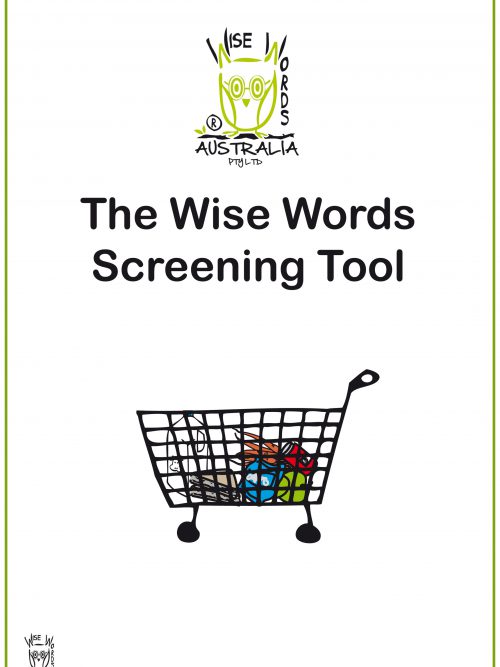 (‘Spot Bakes a Cake’ by Eric Hill) A Screening tool based on the Blank's Model of Classroom Language This simple test, based on the Blank’s Model of Classroom Language (Blank, Rose & Berlin 1978), offers teachers and clinicians a screening tool which is quick and easy to administer. The pictures in the book ‘Spot Bakes a Cake’ provide the stimulus for the questions. Contents - A range of questions/instructions represent all four levels of Blank’s model. This screener offers two questions/instructions at each level for each picture presented. Space is provided beneath these questions for the clinician/teacher to transcribe the child’s response. It is not necessary to ask every question and many children would be unable to sustain interest if all questions were posed. The questions have been arranged into two sets to ensure that a variety of question types is included in each set. For screening purposes, one set is highlighted on the test form. It is recommended that you ask only one set of questions as each set of questions will ensure that you gain a functional picture of a child’s level of understanding. This simple screening tool can be used to plan goals for children and will monitor a child’s progress over time. On completion of the screener, the clinician or teacher enters the raw score of the number of questions asked at each level and the number of correct responses. The number correct at each level is then calculated as a percentage. The criteria referred to in this screener are provided by Marion Blank et al in the following publications ... • The Language of Learning: The Preschool Years - Blank, Rose & Berlin,1978 • Preschool Language Assessment Instrument (PLAI) - Blank, Rose, Berlin, Laura, 1978 Examples of questions provided in the screener: Level 3 Selecting an object by excluding a specific object Find something that is red but is not an apple. Selecting an alternative Sally is holding a cloth. Tell me something else that she could use to pick up the cake. Describing an event that might happen Sally is reading her shopping list. What will she do next? Defining a word What is an egg? Tell me what an egg is. Identifying Similarities This is a card and this is an envelope. How are these things the same? Generalising about a set of events (Point to the bones scattered on the table.) What happened to these bones? Citing an example by excluding a set of objects Tell me something that you can’t wear.
(‘Spot Bakes a Cake’ by Eric Hill) A Screening tool based on the Blank's Model of Classroom Language This simple test, based on the Blank’s Model of Classroom Language (Blank, Rose & Berlin 1978), offers teachers and clinicians a screening tool which is quick and easy to administer. The pictures in the book ‘Spot Bakes a Cake’ provide the stimulus for the questions. Contents - A range of questions/instructions represent all four levels of Blank’s model. This screener offers two questions/instructions at each level for each picture presented. Space is provided beneath these questions for the clinician/teacher to transcribe the child’s response. It is not necessary to ask every question and many children would be unable to sustain interest if all questions were posed. The questions have been arranged into two sets to ensure that a variety of question types is included in each set. For screening purposes, one set is highlighted on the test form. It is recommended that you ask only one set of questions as each set of questions will ensure that you gain a functional picture of a child’s level of understanding. This simple screening tool can be used to plan goals for children and will monitor a child’s progress over time. On completion of the screener, the clinician or teacher enters the raw score of the number of questions asked at each level and the number of correct responses. The number correct at each level is then calculated as a percentage. The criteria referred to in this screener are provided by Marion Blank et al in the following publications ... • The Language of Learning: The Preschool Years - Blank, Rose & Berlin,1978 • Preschool Language Assessment Instrument (PLAI) - Blank, Rose, Berlin, Laura, 1978 Examples of questions provided in the screener: Level 3 Selecting an object by excluding a specific object Find something that is red but is not an apple. Selecting an alternative Sally is holding a cloth. Tell me something else that she could use to pick up the cake. Describing an event that might happen Sally is reading her shopping list. What will she do next? Defining a word What is an egg? Tell me what an egg is. Identifying Similarities This is a card and this is an envelope. How are these things the same? Generalising about a set of events (Point to the bones scattered on the table.) What happened to these bones? Citing an example by excluding a set of objects Tell me something that you can’t wear. -
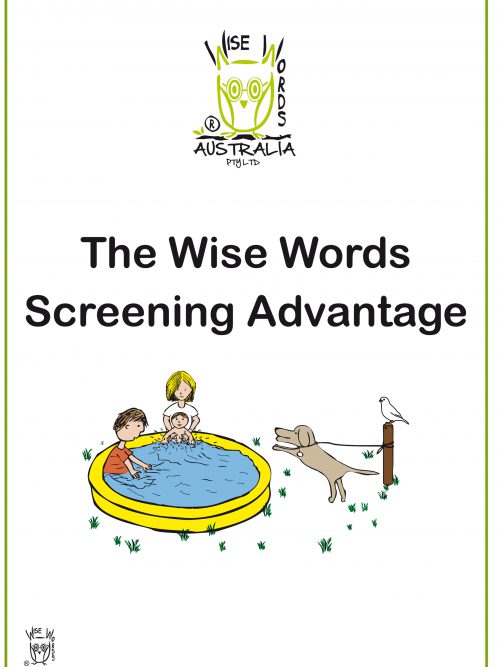 This assessment tool is modeled on the Blank’s Model of Classroom Language Blank, Rose & Berlin 1978 The Wise Words Screening Advantage offers an assessment tool which is quick and easy for clinicians and teachers to administer. Ten colour pictures provide the stimulus for the questions and instructions. The questions/instructions have been designed to represent all four levels of Blank’s model and offer two questions/instructions at each level for each picture presented. This screening tool can be used to plan goals for children and will monitor the child’s progress over time. Contents - The questions/instructions have been designed to represent all four levels of Blank’s model and offer two questions/instructions at each level for each picture presented. The test form provides space beneath the prompts/questions for the clinician/teacher to transcribe the child’s response. A comprehensive table is available to allow more detailed analysis of the child's responses. The question types have been arranged into two sets, (either highlighted or non-highlighted) in order to provide the option of retesting the child without compromising the outcome. Each set ensures that the results reflect the child’s functional level of understanding. On completion of the screener, the clinician or teacher enters the raw score of the number of questions asked at each level and the number of correct responses. The number correct at each level is then calculated as a percentage.
This assessment tool is modeled on the Blank’s Model of Classroom Language Blank, Rose & Berlin 1978 The Wise Words Screening Advantage offers an assessment tool which is quick and easy for clinicians and teachers to administer. Ten colour pictures provide the stimulus for the questions and instructions. The questions/instructions have been designed to represent all four levels of Blank’s model and offer two questions/instructions at each level for each picture presented. This screening tool can be used to plan goals for children and will monitor the child’s progress over time. Contents - The questions/instructions have been designed to represent all four levels of Blank’s model and offer two questions/instructions at each level for each picture presented. The test form provides space beneath the prompts/questions for the clinician/teacher to transcribe the child’s response. A comprehensive table is available to allow more detailed analysis of the child's responses. The question types have been arranged into two sets, (either highlighted or non-highlighted) in order to provide the option of retesting the child without compromising the outcome. Each set ensures that the results reflect the child’s functional level of understanding. On completion of the screener, the clinician or teacher enters the raw score of the number of questions asked at each level and the number of correct responses. The number correct at each level is then calculated as a percentage. -
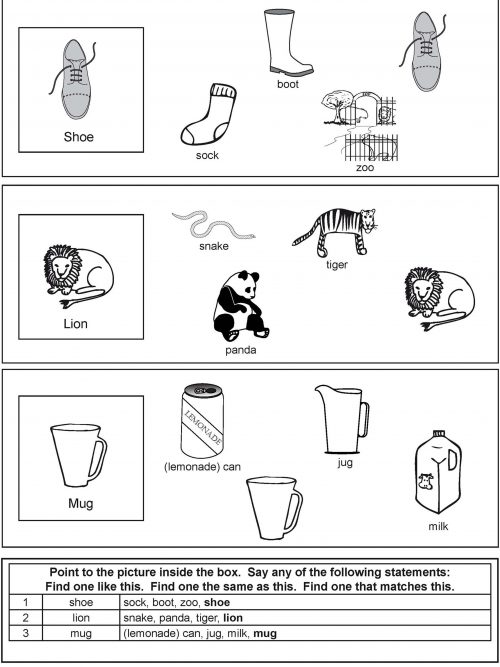
Level 1
Scanning for a Matching Object Level 1 “Find one like this.” “Find one that matches this.” “Find one the same as this.” Naming an Object Touched Level 1 “What is the name of the thing you just touched?” “What’s the thing that you just touched called?” “The thing you touched is under here. (Pointing to the same object but now covered.) What’s it called?” These worksheets are targeted at Level 1 - The questions and statements at this level require a child to understand or respond to information which is “here and now” and always in front of the child. Some early responses may consist of non-verbal gestures (pointing) or single words. This program has been designed to help your child identify and match objects. This is a first step for classifying objects into groups or sets. The other objects present may be related to the word by function (a shoe, boot, and a sock are for wearing on your feet), association (a lion and a tiger are both wild animals) or the word may sound the same (mug-jug). 1. Example of an activity "Point to the object within the square box. Say: “Find one the same as this.” or “Find one that matches this.” or “Find one like this.” 2. Example of an activity "Ask your child to touch the object in the square box. Say: “Touch this.” or “Put your finger on here.” Now ask: ”What’s it called?” or “What’s the name of the thing you just touched?” 3. Example of an activity "Cover the object in the square box with a small piece of card. Say: “The thing you just touched is under here.” Ask: “What’s the name of the thing you just touched?” -
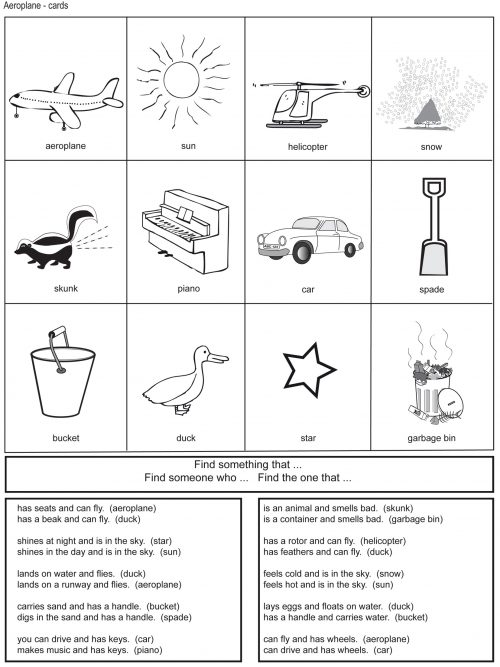
Level 2
Attending to two characteristics Level 2 “Find something that is ... and ... .” “Show me one that has ... and ... .” Understanding the function of objects Level 2 “Show me something that you can ... and has ... .” “Find one that is for ... and has ... .” Attending to two characteristics - This activity will help your child to focus on two features of an object, animal or person. It is important to make sure that your child recognises and is able to name each picture on the page before you ask him to select an item according to your description. While many children are able to recognise subtle characteristics of objects, animals or people, others may need further support to be able to attend to two characteristics at one time. Therefore, before giving your instructions, you may wish to spend some time exploring and talking about each item on the page Barrier Games - The aim of a barrier game is for one player (the Speaker) to describe his picture whilst the other player (the Listener), recreates an identical picture. The pictures are compared and adjusted (if required) after completion. A barrier is placed between the players. Two Characteristics Find the one that lands on water and flies. Show me the one that lands on a runway and flies. . Barrier Games Put the one that has seats and can fly next to the waterfall. Put the one that has a beak and can fly below the volcano. -
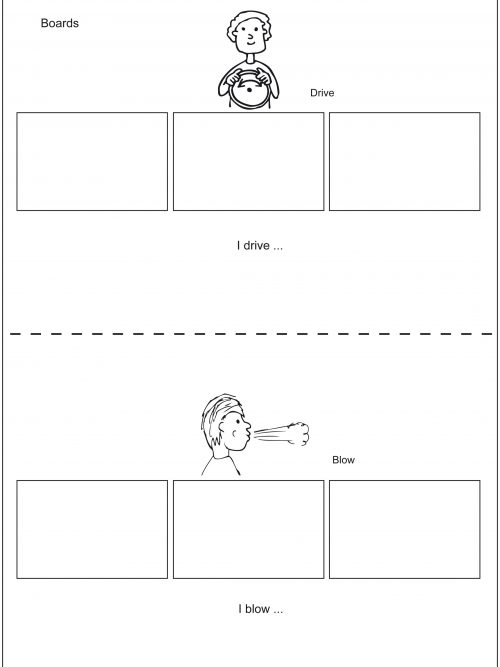
Level 2
Naming the functions of objects Level 2 “What do we do with this?” “What is a ... for?” “What do we use this for?” Citing an example within a category Level 2 “Yesterday I bought something to eat. What could I have bought?” “My naughty dog chewed my clothes. What clothes did he chew?” These worksheets are targeted at Level 2 of Marion Blank’s 'Model of Classroom Language'. The activities will help your child understand the function of objects, what the objects are used for and what we do with them. Function - describes ...- What we do with something (eat cake).
- What we use it for (cut with scissors).
- What it does or what it can do (a helicopter flies, a bee can sting).
- Select objects according to their function.
- Sort objects with similar functions.
- Name the functions of objects.
- Identify the odd one out by recognising the object’s function.
-
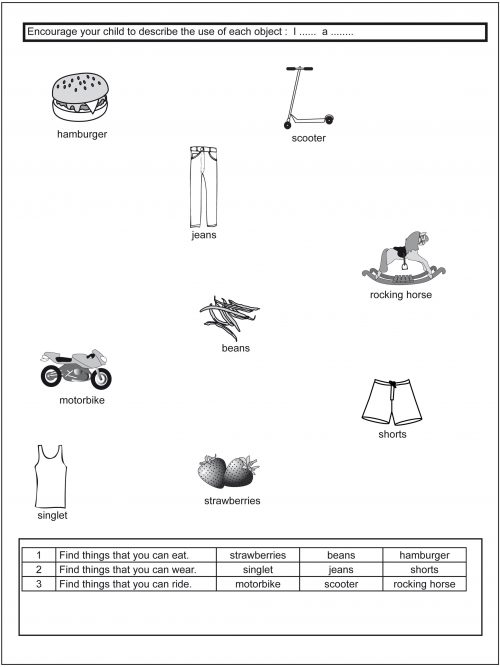
Level 2
Sorting the Functions of Objects Level 2 “What do you do with a ...?" “What do you use a ... for?” “Find me something that you can ... with.” "Find all the ones that I can wear." "Find something that I can ride on." All Wise Words Language programs are underpinned by Marion Blank’s 'Model of Classroom Language'. This program will target Level 2 questions and statements. A Level 2 question requires your child to direct her attention to the material directly in front of her, but at the same time she will need to focus more selectively on this material. Recognising the function of objects is an early concept for children. By using these worksheets, you will help your child understand how objects can be used and what objects can be used for. In addition to identifying objects which match the named function, your child is also encouraged to describe the use of the objects in their selection. Each page contains three different functions with each function represented by three different objects. -
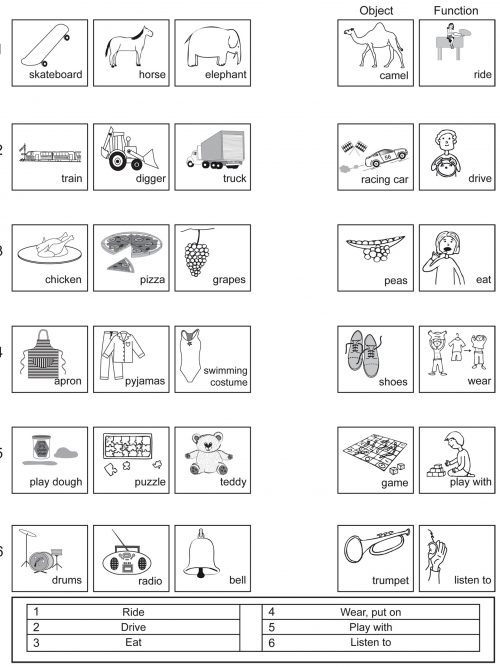
Level 2
Naming the Functions of Objects Level 2 “What do we do with this?” “What is a ... for?” “What do we use a ... for?” Completing a Sentence Level 2 “You finish what I say .. " "I kick a ...” “I eat ...” “... is for eating” These worksheets are targeted at Level 2. The activities will help your child understand the function of objects, what objects are used for and what we do with them. Research indicates that we store and retrieve words more easily if they have been organised into “collections”. Classifying is an important skill for a child to learn. Understanding the function of objects is generally the first characteristic that a child attaches to an object. Your child will quickly realise that juice is for drinking and that a bed is for sleeping in. This program ensures that your child will be able to:- Select objects according to their function.
- Sort objects with similar functions.
- Name the functions of objects.
- Identify the odd one out by recognising the object’s function.
-
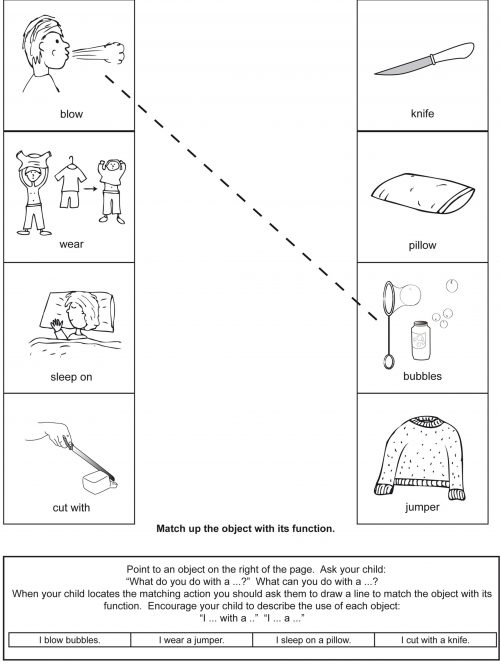
Level 2
Naming functions of objects Level 2 “What do you do with bubbles?” → “I blow bubbles.” “What do you use a pillow for?” → “I sleep on a pillow.” Completing a sentence Level 2 “I cut with a ...” “I wear a...” "I blow ..." Recognising the function of objects is an early concept for children. These worksheets will be useful for teaching your child how objects are used and what they are used for. Recognising the function of objects is an early concept for children. These worksheets will be useful for teaching your child how objects are used and what they are used for. Four objects are placed on the left of each page and the matching four functions are represented on the right of the page. Your child will learn to match the action with the appropriate object and alternatively match the object with its function. This program will help your child to increase their vocabulary and understanding of verbs (action words). You will encourage your child to ‘make a sentence’ for each object they match to an action. (“I cut with a knife.”) Example of a task/activity Give your child a pencil and ask him/her to find the pictures that match. Point to the object on the left side of the page and ask: “What do you do with a knife?” “I cut with a knife.” Encourage your child to draw a line to match the object with its function. Now point to the next picture on the left side of the page and ask: “What do you do with a pillow?” “I sleep on a pillow.” Again ask your child to draw a line to match the object with its function. Continue in this manner until you have matched each object with its matching action (verb). -
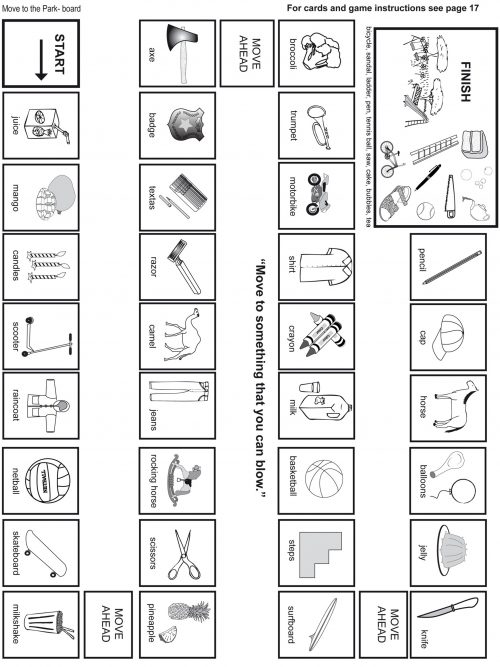
Level 2
Identifying objects according to their function/use Level 2 ““What do you use … for?” “What do you use to ...?” “What do you do with a ...?” “Find something that you can…” Scanning for an object defined by its function Level 2 “Find something that you can dig with.” “Show me something that I can use to ...” “Point to the ones that I can drink.” “Touch the ones that you can drive.” This program provides opportunities to teach more verbs and help children understand that objects have functions - Playing the games provided in this program will increase your child’s command of verbs (action words) and help to expand his/her vocabulary and sentences. Working through the provided activities will help your child understand the link between objects and functions and will ensure that he/she remains engaged in the presented tasks. Research indicates that vocabulary size is a major contributor to language development. It is important for children to make a meaningful connection between an object and an action and thus expand their vocabulary. Verbs lay the foundation for the meaning of early sentences. Providing additional connections such as understanding functions, helps a child learn and find words in a more timely manner. Example of a game: This This game does not require a die. The movement cards describe an action. These cards are cut up and placed face down in a pile next to the board. Each player takes turns to pick up a card from the pile, saying the words ... “Move to something that you can ...” The player moves his/her counter to the first square on the track which matches the action card selected. Cards are placed in the discard pile after each turn. When all the cards have been discarded, the stack should be turned over and the players continue drawing cards from the pile, creating a sentence and moving to a matching object until one player reaches the finish. -
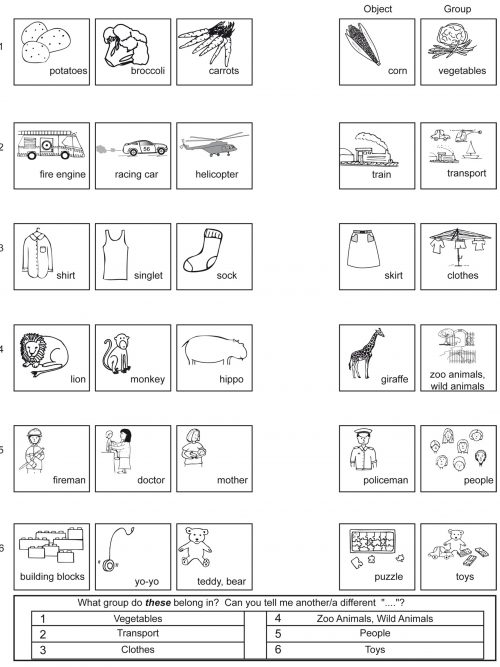
Level 2
Citing and grouping an object within a category Level 2 “Find something that is a food." "Noodles, cheese, bread - which group do these belong in?" All Wise Words Language programs are underpinned by Marion Blank’s Model of Classroom Language. This program will target Level 2 type questions and statements. Research indicates that we store and retrieve words more easily if they have been organised into “collections”. Two important ways that we can organise words are according to: Function - (what we do with something (eat cake), what we use it for (cut with scissors) or what it does (a bird flies). Semantic Class - A “word family” which includes groups such as food (cake, eggs, bread, cheese), wild animals (zebra, giraffe, lion, monkey), furniture (chair, bed, table, shelves). These worksheets have been designed to help your child recognise Semantic Categories. Your child will learn to group objects into categories and they will learn to use category labels. Example of an activity: Point to the first row of objects on the page. Encourage or help your child name each object. Say: “What group do these belong in?” “vegetable” Now ask your child to find the picture of the vegetable group and place it next to the row of vegetables. Next ask your child: “Can you tell me another vegetable?” or “Can you find me a different vegetable?” “corn” If your child cannot recall an alternative vegetable to the three already depicted, you may wish to offer him/her a choice of three other objects .... "Is a giraffe a vegetable?" "Is a train a vegetable?" "Is corn a vegetable? Yes, corn is a vegetable and corn belongs in the vegetable group." -
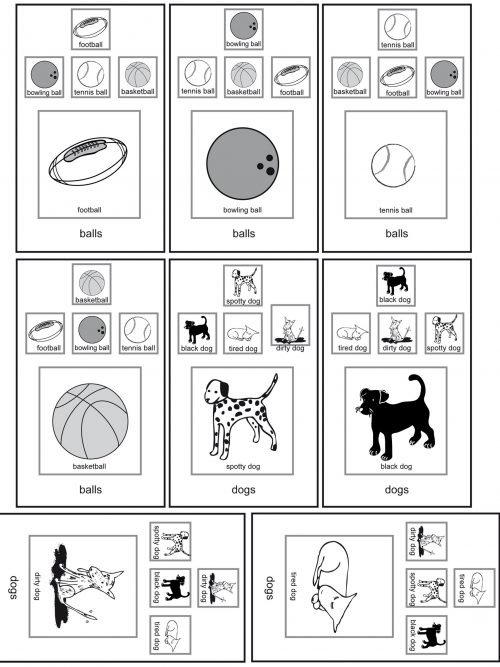
Level 2
Naming and grouping an object within a category “Find something that is a food." "Hamburger - which group does this belong in?” “Is this in the furniture group?” “Which group are you collecting?” “What belongs in your group?” Attending to two characteristics “Find something that gives milk and eats grass.” “Find something that is an animal and has a long neck.” “Find the things that grow and we can eat.” This program provides opportunities to teach the concept of semantic groups/grouping of objects. - Children learn new words more easily if they fully understand the meaning of a word. Therefore, it is important for the child to understand the semantic features and how a word can be categorised. Initially he is required to group non-identical but almost the same objects. The semantic features and similarities of each object are discussed and sorted using the ‘Group Board’. This activity gives the child a number of links to the non-identical objects (cars) or group name (e.g. fruit, transport). Discussing and comparing the semantic features of objects provides a ‘mapping’ experience to ensure that the word is learnt more successfully. This program can also be used to target and identify similarities or differences while providing the child with additional information to use inductive reasoning. Research indicates that we store and retrieve words more easily if they have been organised into ‘collections’. Two important ways that we can organise words are by ... • Function - what we do with something (eat cake), what we use it for (cut with - scissors) or what it does (a bird flies). • Semantic Class - A ‘word family’ includes groups such as food (cake, eggs, bread, cheese), wild animals (zebra, giraffe, lion, monkey), furniture (chair, bed, table, shelves). This program targets the classification of objects into Semantic Classes whilst providing the child with multiple links which they can use to retrieve the words at a later time. Initially the child is presented with objects which are similar (all balls) but not identical (e.g. football, tennis ball, bowling ball, basketball). Once a child is able to group non-identical objects into groups, the Semantic Class cards and boards are presented (e.g. food, furniture, clothes, farm animals). Contents - 34 pages including instructions. -
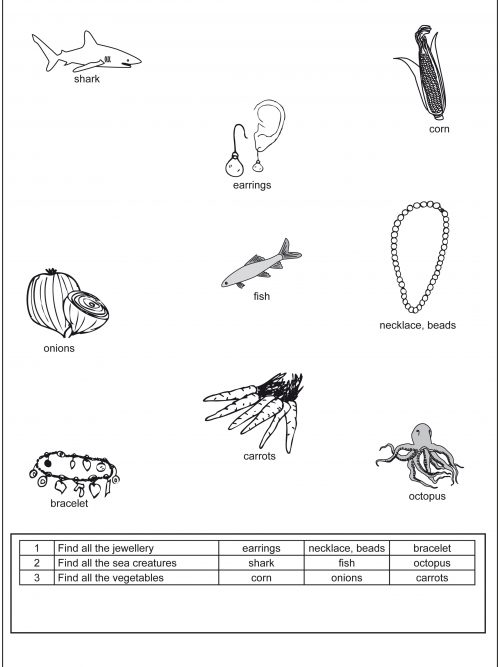
Level 2
Naming a Semantic Class Level 2 “Hamburger, cheese and bread are all ...?” “What group do hamburger,cheese and bread belong in?” “I went shopping and I saw some food.” “What food could I have seen?” Sorting According to Semantic Class Level 2 “Find all the food.” “Find something that is a food.” “Show me all the food.” All Wise Words Language programs are underpinned by Marion Blank’s “Model of Classroom Language”. This program will target Level 2 questions and statements. The activities in this program will help your child to sort materials into groups and use the collective group name for objects. Research indicates that we store and retrieve words more easily if they have been organised into “collections”. Two important ways that we can organize words are according to: Function - what we do with something (eat cake) Semantic Class - A “word family” which includes groups such as food (cake, eggs, bread) This program will focus your child’s attention on the concept of Semantic Groups. He/she will learn how to group objects into categories and how to use category labels. Three semantic groups are represented on each page and your child is required to identify the objects which belong in a specific semantic group. Example of an activity: Give your child a coloured pencil and ask him/her to find all the farm animals. Your child will circle and name each farm animal as he/she finds it on the page. Next, give your child a different coloured pencil and ask him/her to find all the fruit. Now give your child another coloured pencil and ask your child to find all the clothes. -
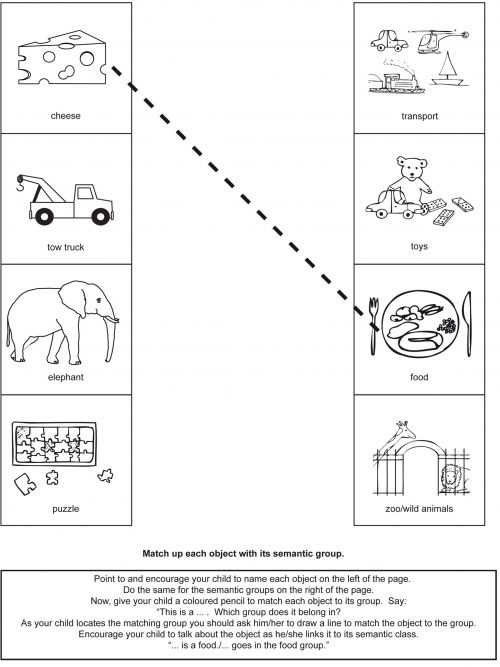
Level 2
Naming and grouping an object within a category “Find something that is a food." "Hamburger - which group does this belong in?” “Is it the furniture group?” “Which group are you collecting?” “What belongs in your group?” Citing an Example within a Category “Name something that is a food." "Tell me something that belongs in the kitchen.” “Find something that is a farm animal.” “Point to something that belongs in the sky.” Contents/product description - Research indicates that we store and retrieve words more easily if the words are arranged into ‘collections’. Two important ways that we can sort and group words are by ...- Function - what we do with something (eat cake), what we use it for (cut with scissors) or what it does (a bird flies).
- Semantic Class - A ‘word family’ which includes groups such as food (cake, eggs, bread, cheese), wild animals (zebra, giraffe, lion, monkey), furniture (chair, bed, table, shelves).
-
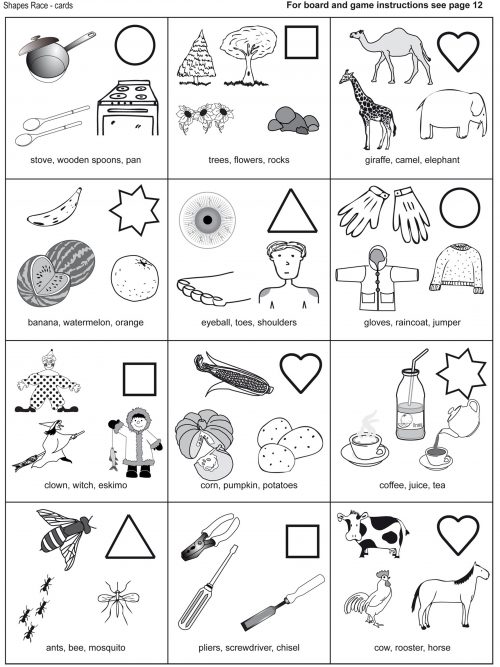
Level 2
Naming a semantic class Level 2 “A watermelon, a banana and an orange are all ...?” “What group do toes, eyeballs and shoulders belong in?” “I went shopping for new clothes. What did I buy?” Sorting according to a semantic class Level 2 “Find all the vegetables.” “Find something that is an insect.” “Show me all the farm animals.” Citing an example within a category Level 2 “Name something that is a drink.” “Tell me something that is a vegetable.” “Show me something that belongs in the transport group.” “I went to the zoo. Tell me something that I saw at the zoo.” Contents/product description - This program targets Blank’s Level 2 questions and statements. Playing the games provided in this program will help your child to understand that objects can be grouped into categories and that categories have labels (fruit, vegetables, clothes, tools, zoo animals). Playing a number of different games all targeting the same language goal will further stablise these concepts whilst ensuring that your child is engaged. Research indicates that we store and retrieve words more easily if they have been organised into ‘collections’. Working through these activities will help to increase your child’s vocabulary and improve his/her word finding skills. A child may ‘know’ a word and he may point to the appropriate object when it is named but he may not be able to retrieve the word at all or be able to retrieve the word in a timely manner. Playing the games in this program will be enjoyable for your child and should ensure that he/she repeats the tasks numerous times which will help him/her fully understand the concept. -
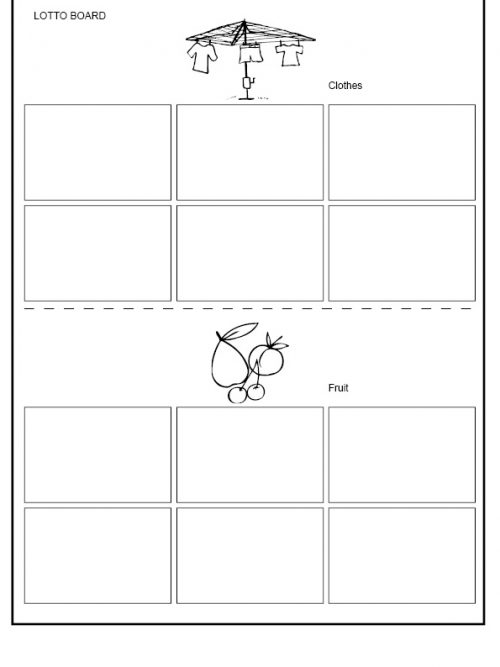
Level 2
Citing and grouping an object within a category Level 2 “Find something that is a food." "Hamburger - which group does this belong in?" "Is it the furniture group?” “Which group are you collecting?” “What belongs in your group?” Attending to two characteristics Level 2 “Find something that is round and is a food." "Noodles, cheese, bread - which group do these belong in? “Find something that is an animal and has a long neck.” Level 2 questions require your child to direct their attention on the material directly in front of them, but at the same time he/she will need to focus more selectively on this material. Research indicates that we store and retrieve words more easily if they have been organised into 'collections'. Two important ways that we can organise words are according to: Function - what we do with something (eat cake), what we use it for (cut with scissors) or what it does (a bird flies). Semantic Class - A 'word family' which includes groups such as food (cake, eggs, bread, cheese), wild animals (zebra, giraffe, lion, monkey), furniture (chair, bed, table, shelves). The activities in this program will help your child to sort materials into semantic groups and use the collective group name for objects. For example: clothes - jumper, jeans, shirt, socks, dress, singlet fruit - apple, banana, orange, pineapple, grapes, watermelon The lotto boards, individual object cards and group cards can be used in a number of different activities and games. Varying the task will ensure that your child remains engaged and focused on the activities, whilst repeating the task several times. -
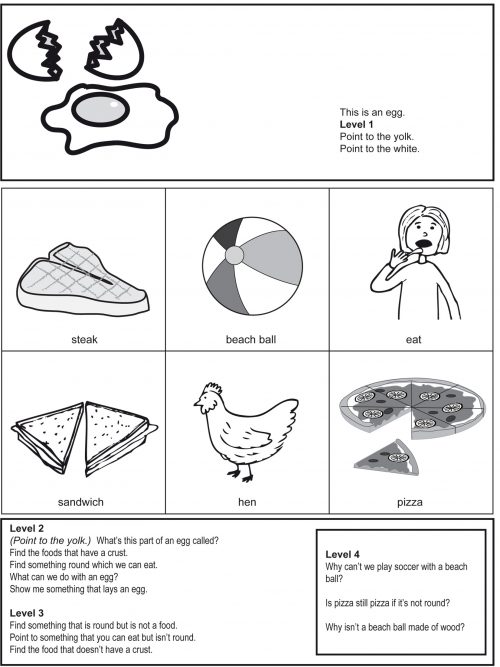
Levels 2 - 4
Attending to Two Characteristics Naming the Parts of Objects Identifying an Object by its Function Level 2 “Find something that is round and we can eat.” “What is this part of a ... called?” “What do we use this for?” Selecting an Object by Exclusion Selecting a Set of Objects by Exclusion Level 3 “Find all the ones that are not animals." "Tell me something that is not big." “Show me something that can jump but is not a horse." Reasoning and Problem Solving Level 4 “If a bicycle wheel were square would it still be a wheel?” “Why are gumboots made of rubber?” “What will happen if ...?” "Why is a raincoat called a raincoat?" The first part of this program has been designed to help your child recognise and name parts of objects and respond to questions which focus on the object's properties and functions. (eg Selecting an object according to two characteristics – “Find the one that has an engine and wings.”) The second part of this program targets exclusion. This requires your child to overcome the urge to respond to a key word or salient perceptual material. (eg “Point to something that you can eat but isn’t round. Find something that flies in the sky but doesn't have wings.”) The final part of this program represents complex verbal problems that require a child to reason about what may, might, could or would happen to material/objects under specific circumstances. Your child will need to problem solve and formulate solutions using logic and past knowledge. Although the question may relate to an object pictured on the page, the solution to the question is not present. Example of tasks/activities Level 2 Find something round which we can eat. What's this part of a helicopter called? Level 3 Point to something that you can eat but isn't round. Point to something that is a boat but doesn't have sails. Level 4 Why isn't a beach ball made of wood? Would a soccer ball still be a soccer ball if it were an oval shape? -
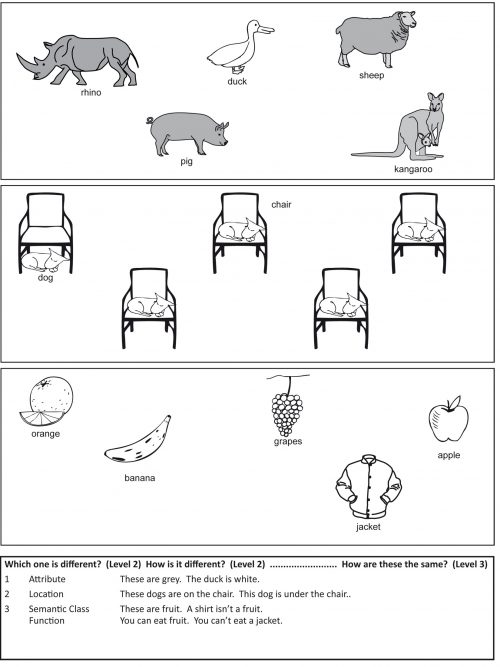
Level 2 and Level 3
Identifying Differences Level 2 “Which one is different?" "Which one is not the same?" "Which one doesn’t match?" "How are these different?" Identifying Similarities Level 3 “How are these the same?" The first activity (Level 2) will help your child to identify differences and be able to explain how something is different. This is an important skill as it directs the child’s attention to further aspects or properties of an item. This Level 2 question is simpler than the more complex question “How are these the same?” The second activity (Level 3) will help your child to identify similarities within a group of objects. This is an important skill for children to acquire as they are often able to recognise differences between objects and yet they cannot always explain how objects can share similarities. This Level 3 question is more complex because now your child has to perceive similarities between objects which may, or may not, be obvious or immediately perceived . Example of a Level 2 Activity Ask your child to point to and name the objects: “Dog, duck, pig, sheep, horse” Now ask: “Which one is different?” - "Duck" If your child points to the correct item but does not verbalise, she should be encouraged to name the item. - “duck.” Point to the duck and ask: “How is it different?” - “The duck is white. The other animals are grey.” Point to the duck and ask: “How is it different?” - “The duck is white. The other animals are grey.” Example of a Level 3 Activity Ask your child to point to and name the objects: "Needle, knife, scissors, apron, saw" Now cover the apron with card and whilst pointing to the remaining objects ask: "How are these the same?" - “These are sharp. An apron isn't sharp.” -
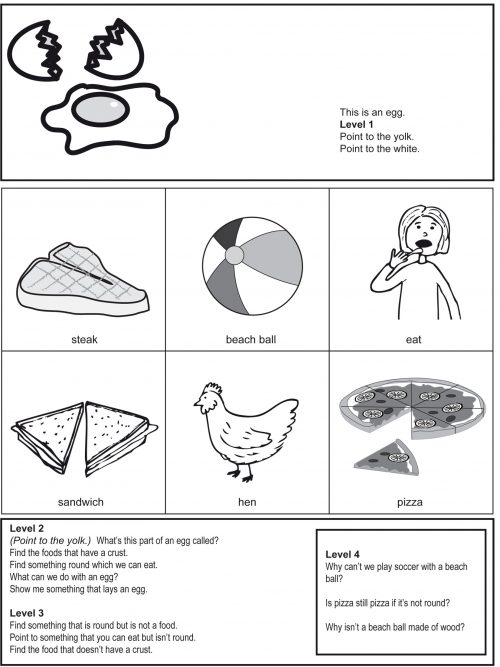
Identifying Parts of a Whole and Exclusions Level 2 - 4
Attending to Two Characteristics Naming the Parts of Objects Identifying an Object by its Function Level 2 “Find something that is round that we can eat.” “What is this part of a ... called?” “What do we use this for?” Selecting an Object by Exclusion Selecting a Set of Objects by Exclusion Level 3 “Find all the ones that are not animals." "Tell me something that is not big." “Show me something that can jump but is not a horse." Reasoning and Problem Solving Level 4 “If a bicycle wheel were square would it still be a wheel?” “Why are gumboots made of rubber?” “What will happen if ...?” "Why is a raincoat called a raincoat?" The first part of this program has been designed to help your child recognise and name parts of objects and respond to questions which focus on the object's properties and functions. (eg Selecting an object according to two characteristics – “Find the one that has an engine and wings.”) The second part of this program targets exclusion. This requires your child to overcome the urge to respond to a key word or salient perceptual material. (eg “Point to something that you can eat but isn’t round. Find something that flies in the sky but doesn't have wings.”) The final part of this program represents complex verbal problems that require a child to reason about what may, might, could or would happen to material/objects under specific circumstances. Your child will need to problem solve and formulate solutions using logic and past knowledge. Although the question may relate to an object pictured on the page, the solution to the question is not present. Examples of tasks/activities Level 2 Find something round which we can eat. What's this part of a helicopter called? Level 3 Point to something that you can eat but isn't round. Point to something that is a boat but doesn't have sails. Level 4 Why isn't a beach ball made of wood? Would a soccer ball still be a soccer ball if it were an oval shape? -
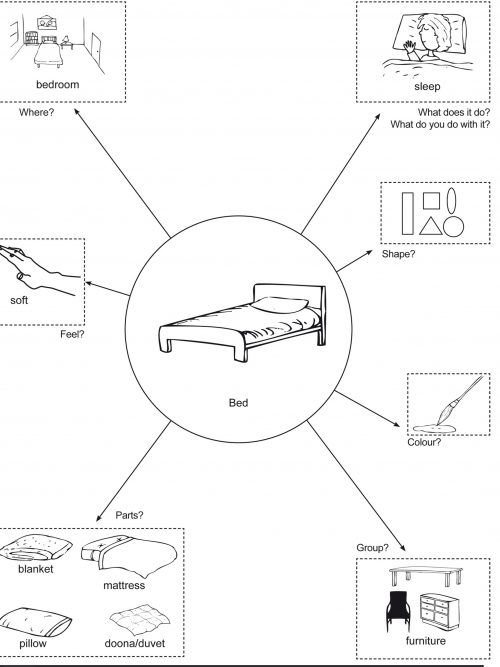
Level 3
Defining Words Level 3 “What is a ...?” “Tell me what a ... is.” “Tell me what ... are.” Mind Maps will help your child to- Talk about and describe an object
- Give 'news'
- Expand his/her vocabulary
- Find the right word
- Increase his/her descriptive language
- Answer questions
- Ask questions
- Where do you find it?
- What does it do? What can you do with it?
- What shape is it?
- What colour is it?
- What group (semantic class) does it belong in?
- What noise does it make?
- What parts does it have? (Labeling the parts of objects greatly increases a child's vocabulary. For example - fleece, hooves of a sheep)
- How does it feel (when touched)?
- When your child becomes competent with the object specific prompts you should introduce the generic mind map which is provided at the end of the program.
-
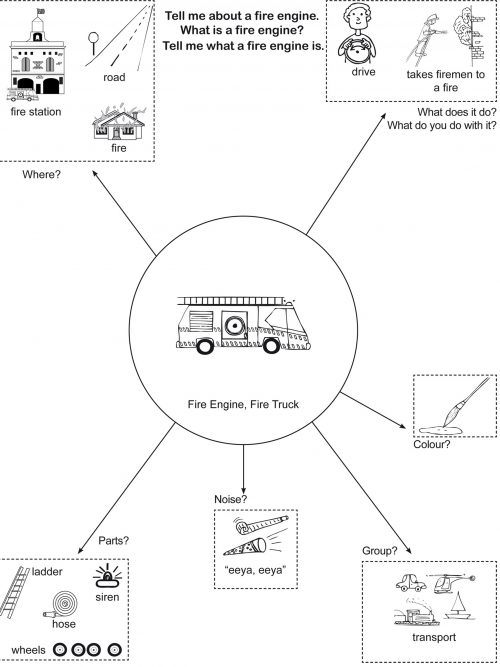
Level 3
Defining Words Level 3 “What is a ...?” “Tell me what a ... is.” “Tell me what ... are.” Mind Maps - will help your child to- Talk about and describe an object
- Give 'news'
- Expand his/her vocabulary
- Find the right word
- Increase his/her descriptive language
- Answer questions
- Ask questions
- Where do you find it?
- What can you do with it?
- What shape is it?
- What colour is it?
- What group (semantic class) does it belong in?
- What parts does it have? (Labelling the parts of objects greatly increases a child's vocabulary. For example - yolk, white, shell)
- How does it feel (when touched)?
- When your child becomes competent with the specific prompts, a generic mind map is provided.
-
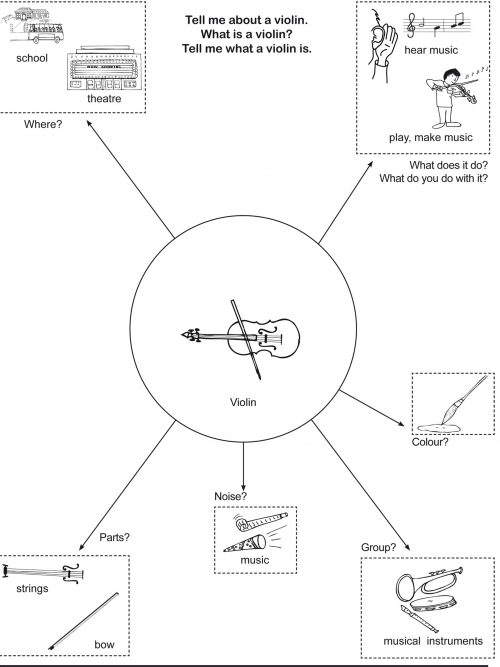
Level 3
Defining Words Level 3 “What is a ...?” “Tell me what a ... is.” “Tell me what ... are.” Mind Maps will help your child to- Talk about and describe an object
- Give 'news'
- Expand his/her vocabulary
- Find the right word
- Increase his/her descriptive language
- Answer questions
- Ask questions
- Where do you find it?
- How does it feel (when touched)?
- What can you do with it?
- What shape is it?
- What colour is it?
- What group (semantic class) does it belong in?
-
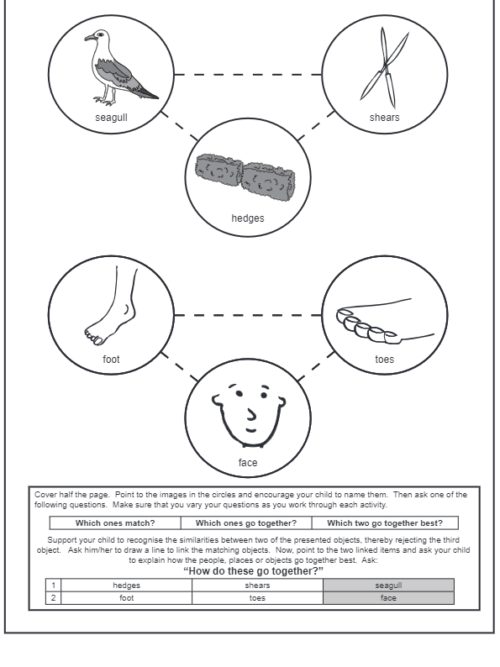
Level 3
Explaining Similarities Find the ones that go together best. Find the ones that match. How are these the same? How do these go together? Although a child may be able to recognise differences between objects, often he is not able to explain how similarities can be shared. At Level 3, the child is required to perceive relationships between items which may, or may not, be immediately obvious. He may need to draw on past experiences or knowledge rather than rely on the ‘here and now’ features or the more obvious characteristics. A set of pictures may have more than one similarity. For example: a foot, a face and toes are similar as they are all parts of the body (same semantic class). The child then needs to recognise that a closer relationship exists - that the toes are part of a foot. -
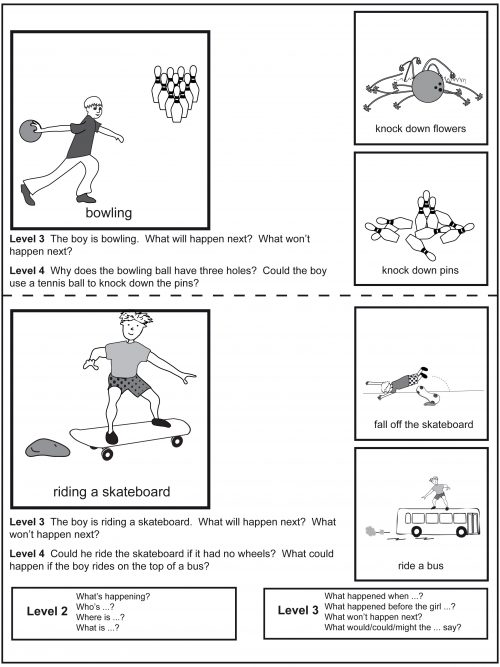
Level 3
Describing an event that might happen Level 3 “What might happen next?” “What will happen next?” “What could happen next?” Describing an event that won't happen Level 3 “What won't happen next?" "What won't the boy do next?" Reasoning, justifying and predicting Level 4 “Would a bowling ball be a bowling ball if it were made of cotton wool?” “How could the boy avoid falling off his skateboard?” “Why shouldn't the boy ride on top of the bus?” Contents - Learning to sequence is an important language component for your child. This program will help your child understand and express ordinal and causal relationships. He/she will require sequencing skills to create narratives as his/her language develops. The ability to sequence an event will help your child to organise information and ideas with greater efficiency. As you help your child to sequence stories, this program will also reinforce a number of concepts (first, last, before, after). Working through the program will serve as an early step in developing your child's ability to produce a story. Example of a task/activity Cover the two smaller pictures on the right and ask your child to describe what is happening in the large picture on the left. If your child is unable to describe the event occurring in the large picture, you should model the complete sentence for him/her. "The boy is buying a cake." Next, cover the large picture and uncover the two smaller pictures. Point to each small picture as you ask "What's happening?" or "What happened ...?" Encourage your child to describe what is happening in each picture. Again you should describe the event/s in the picture for your child if he/she is unable to do so. Now uncover all three pictures and ask either "What will happen next?" or "What won't happen next?" To further extend this activity you may wish to ask additional questions such as... "What happened before ...? What happened after...? What happened first?" As a final task you may wish to cover all the pictures in the sequence and point to the left side of the page asking "Tell me the story. Tell me what happened." (You may need to prompt your child with "next ..." and "then ...") -
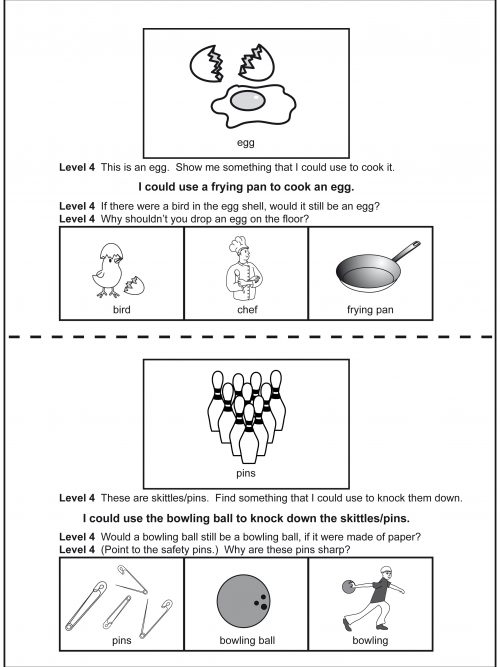
Level 4
Selecting the Means to a Goal Level 4 “What should I use to ...?” “What could I use to ...?” “What might he use when ...?” Explaining the Means to a Goal Level 4 “Why should she use...?” “What made him use ..?” “Why would she use ...?” Explaining obstacles to an action & Formulating a Solution Level 4 “Why can’t he use ... to ...?” “Why shouldn’t we use ...?” “What might happen if he ...?” “What could you use if ...?” “The boy is ... What could he do to ...?” “What would you do if ...?” Contents/product description - This program can be used with both readers and non-readers alike. Questions are used to guide your child through the thinking process so that he/she will reach the appropriate conclusion without being provided with the answer. It is important for the parent, teacher or clinician to lead the child towards the salient features of the presented problem. It may become necessary for the adult to break down the problem scenario into smaller parts to give the child the opportunity to understand. It is then essential to talk more, at a simple level, in language that the child understands. Rephrasing the information will ensure that the child is able to make inferences, understand the problem and then offer a solution. The large picture sets the scene for the child but does not provide answers. Possible solutions (tools) to each problem are located in the three smaller squares below. Example of a task/activity Point to and name the large picture of the loaf of bread. This picture is the feature which the child will need to consider. Now name each of the smaller pictures. The deliberate foil (a slice of bread) may misdirect the child if he/she does not fully understand the question. This topic is concerned with slicing bread. The following solutions are offered: • a knife - the correct answer - something used for slicing • slice of bread - the foil • a spoon - something that is used for eating but not for slicing bread. -
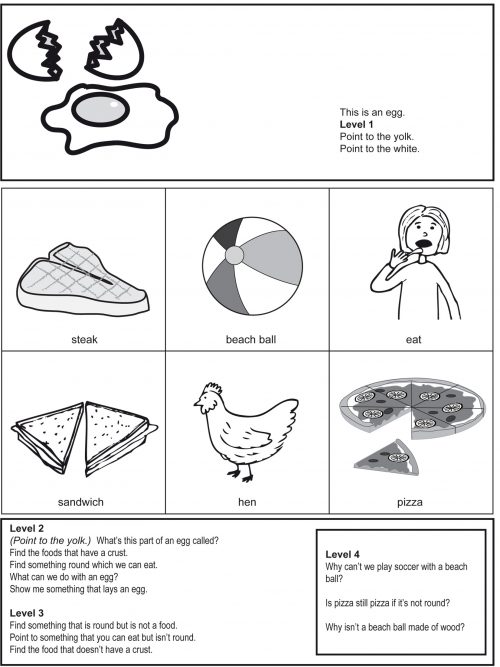
Levels 2 - 4
Level 2 Attending to Two Characteristics Naming the Parts of Objects Identifying an Object by its Function “Find something that is round and we can eat.” “What is this part of a ... called?” “What do we use this for?” Level 3 Selecting an Object by Exclusion Selecting a Set of Objects by Exclusion “Find all the ones that are not animals." "Tell me something that is not big." “Show me something that can jump but is not a horse." Level 4 Reasoning and Problem Solving “If a bicycle wheel were square would it still be a wheel?” “Why are gumboots made of rubber?” “What will happen if ...?” "Why is a raincoat called a raincoat?" The first part of this program has been designed to help your child recognise and name parts of objects and respond to questions which focus on the object's properties and functions. (eg Selecting an object according to two characteristics – “Find the one that has an engine and wings.”) The second part of this program targets exclusion. This requires your child to overcome the urge to respond to a key word or salient perceptual material. (eg “Point to something that you can eat but isn’t round. Find something that flies in the sky but doesn't have wings.”) The final part of this program - represents complex verbal problems that require a child to reason about what may, might, could or would happen to material/objects under specific circumstances. Your child will need to problem solve and formulate solutions using logic and past knowledge. Although the question may relate to an object pictured on the page, the solution to the question is not present. Example of a task/activity Level 2 Find something round which we can eat. What's this part of a helicopter called? Level 3 Point to something that you can eat but isn't round. Point to something that is a boat but doesn't have sails. Level 4 Why isn't a beach ball made of wood? Would a soccer ball still be a soccer ball if it were an oval shape? -
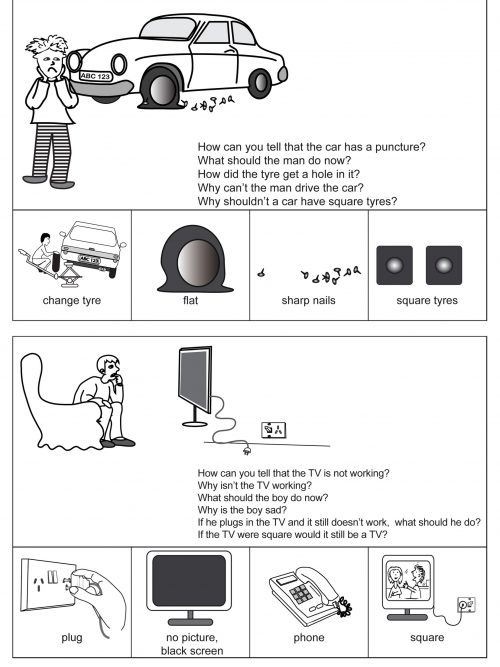
Level 4
Explaining an inference “How can you tell that ...?” “How do you know that ...?” Explaining obstacles to an action “Why can’t the ...?” “Why won’t the ...?" Formulating a solution “What could she do ...?” “What should the ... do ...?” Justifying a prediction “What will happen if ...?” “Why can’t ...?” “Why shouldn’t ...?” Justifying a decision - based on essential and non-essential characteristics “If a ... were ... would it still be ...?” “If a ... were made of ... would it still be ...? Working through this program will improve your child’s verbal organisation. The program will allow your child to attend to and process information, whilst retrieving and comparing this information to past experiences. Your child will need to compare the new verbal information with information which has already been stored. Each scene will offer him/her the opportunity to develop an understanding of more abstract language. It will also improve his/her ability to ignore non-relevant material, yet retain the relevant features or information from each scene. This program will target- Inferential Reasoning - the ability to draw a conclusion based on the facts and previous experiences.
- Problem Solving - the ability to identify obstacles and then formulate a solution to a problem.
- Justifying a Prediction - the ability to explain why an event may take place and why certain actions or behaviours should be avoided.
- Justifying a Decision - based on essential and non-essential characteristics of an object.
- How can you tell that the boy is having a haircut?
- How do you know that the hairdresser hasn’t finished cutting his hair?
- How do you know that the boy is at the hairdresser?
- Why is the boy wearing a cape?
- Why does the boy need to go to the hairdresser?
- What should the hairdresser do after the boy leaves?
-
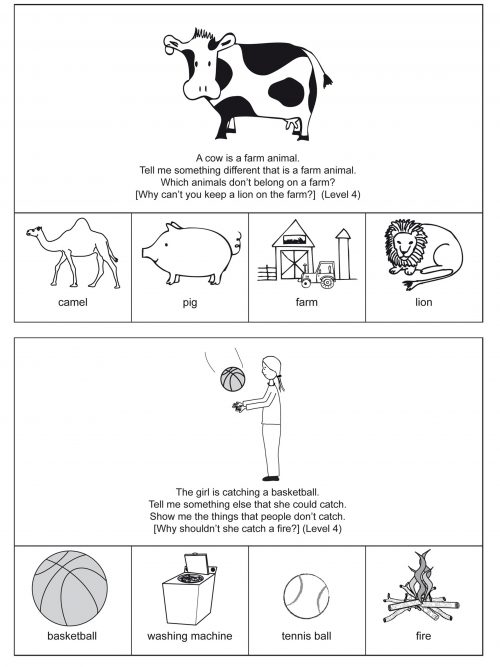
Level 3 (& Level 4)
Selecting an Object or Set of Objects by Exclusion Level 3 “Tell me something else that ...” “Tell me something different that ..." "Show me the things that aren’t ...” “Point to the things that don’t ...” “Find the things that the boy can’t ...” Reasoning Level 4 “Why is a ... made of ...?" "What should he do if ...?" "Why wouldn't ...?" "What could you use to ...?" "What could you ... if ...?" This program targets Level 3 questions and statements. At this level of understanding, your child will need to look beyond the material in front of him/her. He/she will be required to evaluate and reorder the information. A typical skill in this category is the ability to exclude material. Your child will need to follow directions which may use the words ‘not, don’t, can’t, something else, other than’. The activities in this program have been designed specifically to help your child recognise alternatives. A number of Level 4 questions have been included in this program. These tasks will prove useful for those children who are working towards a more abstract type of question. Questions at this level include Why should ...? Why shouldn’t ...? Why can ...? Why can’t ...? What could ...? How can we tell ...? At this level of understanding, your child will need to look beyond the material in front of him/her and will then be required to evaluate and reorder the information. A typical skill in this category is the ability to exclude material. Your child will need to follow directions which may include the words ‘not, don’t, can’t, something else, other than’. The activities in this program have been designed specifically to help your child recognise alternatives. Example of a Level 3 Activity: 1. “A cow is a farm animal. “Tell me something different that is a farm animal.” Your child is given the following possible answers: A camel - An animal but not a farm animal. A pig - The correct answer. This is an alternative farm animal. A farm - The place where farm animals are found. A lion - An animal but not a farm animal. 2. “Which animals don’t belong on the farm?” - “Camel, lion” Example of a Level 4 Activity 1.“Mum fills the kettle with water. How can we tell that the kettle is boiling?" 2. “Frogs can jump. Why can’t snails jump? -
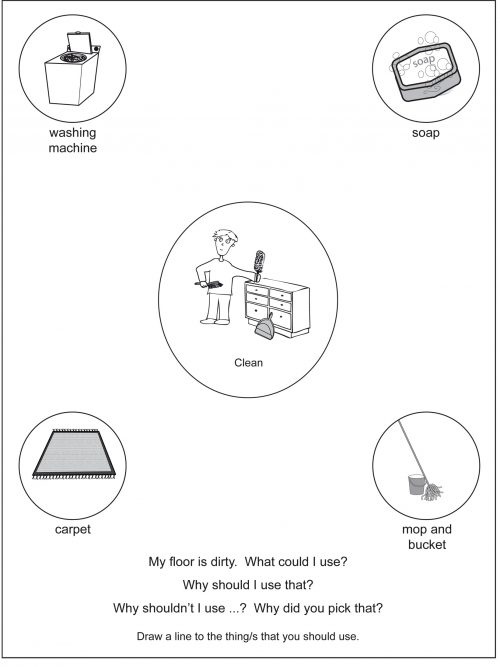
Level 4
Selecting the Means to a Goal Level 4 “What should I use to ...?” “What could I do to ...?” “What could he wear if ...?” Explaining the Means to a Goal Level 4 “Why should she use...?” “Why shouldn’t she use ..?” “Why did you pick that one?” The activities presented in this Level 4 program reflect more complex verbal problems. These activities will require your child to reason about things that may, might, could or would happen. Your will need to go beyond what can be immediately seen or perceived. He/she will need to reflect on previously gained information and use this information to solve the problem. The large circle in the middle of the page contains the “problem” which your child will need to solve. This picture will set the scene for your child but it will not give your child the answer to the question. Possible solutions to each problem are located in the four smaller circles which are placed in each corner of the page. Some solutions have been chosen in order to deliberately challenge your child. For your child to offer the correct solution they will have had to completely understand the statement and understand the question. Example of a problem: This problem is related to cleaning the floor.The following solutions are offered: A washing machine - this is something used for cleaning clothes. Soap - again something for cleaning. A carpet - something that is found on the floor. A mop and bucket - the correct answer for cleaning the floor. -
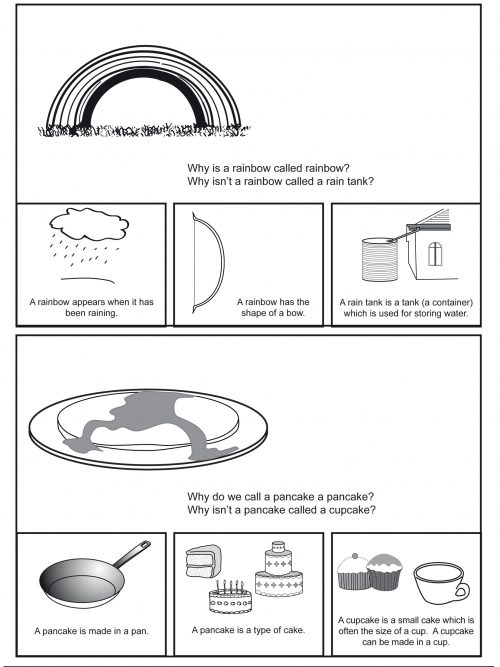
Level 4
Explaining the Logic of Compound Words Level 4 “Why is a ... called a ...?” “Why isn’t a ... called a ...?” “Why do we call this a ... ?” A Compound Word is formed when two or more words, which can stand alone, are joined to make a new word. The new word takes on a new meaning (button + hole = buttonhole, foot + ball = football). This program has been designed to help your child to recognise and explain the reasoning behind compound words. Explaining the logic of compound words is a Blank’s Level 4 level of understanding and makes it necessary for your child to use language to talk about language. At this level, the questions and statements pose more complex verbal problems and will require your child to reason and predict. Asking your child to explain why a ‘waterfall’ is called a ‘waterfall’ requires him/her to analyse the presented word and recognise that it is comprised of two individual words. In addition, he/she needs to understand that the individual words have different meanings when they stand alone. Example of a task/activity “Why is a rainbow called a rainbow?” You should point to the picture of the rainbow and say the following... “This is a rainbow.” Next, you ask your child the question: “Why is a rainbow called a rainbow?” If his/her response is incorrect or inadequate you should point to and talk with your child about the first two smaller pictures below the rainbow. “This is rain. A rainbow appears when it has been raining." Next, talk about the second picture: "Look this is a bow. A rainbow has the shape of a bow.” Now that you have explained the two components of the word ‘rainbow', you should ask again the question relating to the compound word: “Why is a rainbow called a rainbow?” “Why isn’t a rainbow called a rain tank?” Point to the rainbow and then point to and talk about the picture of the rain tank. Ask: “Why isn’t a rainbow called a rain tank?” You may need to help your child focus on the relevant features in the picture by talking more about the rain tank. In this way you will be simplifying the question further. -
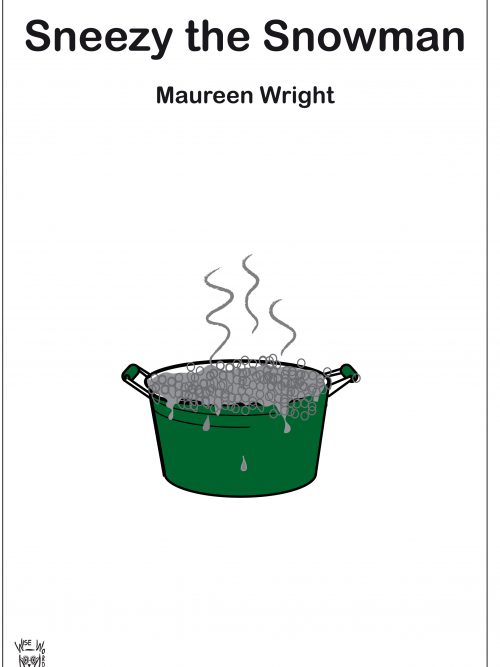 USING BOOKS TO ENHANCE A CHILD'S UNDERSTANDING AND INCREASE HIS/HER EXPRESSIVE LANGUAGE You can use a book to expand a child's • Vocabulary (snowman, shivered, smile, melted, winter, wind) • Understanding of concepts (warm, cold, new, hot, freezing) • Ability to understand questions Wise Words Scripts - offer clinicians, teachers and parents readily available questions designed specifically for each book. A script provides a variety of questions at each level of understanding for each page of the book. A teacher or clinician working with a group of children can tailor questions to each child's language ability. This script and other available scripts have been based on Marion Blank's Model of Classroom Language. Marion Blank recognised the importance of keeping questions and statements within a child’s level of understanding. The more concrete the statement or question, the easier it will be for the child to understand. As questions become more abstract, they become harder for children to answer. The Blank Model is divided into 4 levels of questioning, moving from the concrete (easiest) at Level 1 to the abstract (most difficult) at Level 4.
USING BOOKS TO ENHANCE A CHILD'S UNDERSTANDING AND INCREASE HIS/HER EXPRESSIVE LANGUAGE You can use a book to expand a child's • Vocabulary (snowman, shivered, smile, melted, winter, wind) • Understanding of concepts (warm, cold, new, hot, freezing) • Ability to understand questions Wise Words Scripts - offer clinicians, teachers and parents readily available questions designed specifically for each book. A script provides a variety of questions at each level of understanding for each page of the book. A teacher or clinician working with a group of children can tailor questions to each child's language ability. This script and other available scripts have been based on Marion Blank's Model of Classroom Language. Marion Blank recognised the importance of keeping questions and statements within a child’s level of understanding. The more concrete the statement or question, the easier it will be for the child to understand. As questions become more abstract, they become harder for children to answer. The Blank Model is divided into 4 levels of questioning, moving from the concrete (easiest) at Level 1 to the abstract (most difficult) at Level 4. -
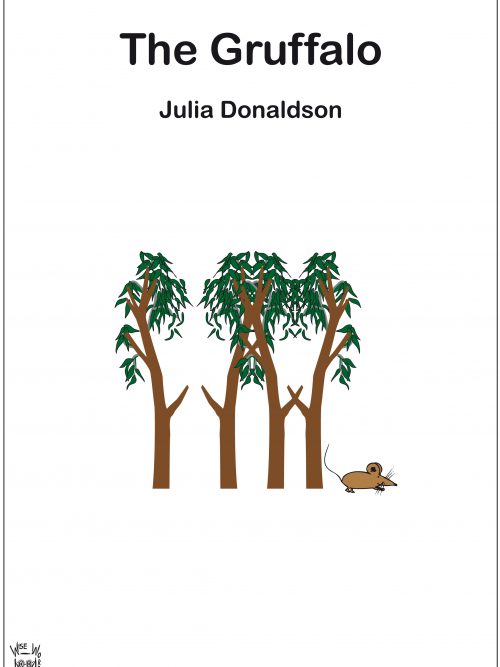 USING BOOKS TO ENHANCE A CHILD'S UNDERSTANDING AND INCREASE HIS/HER EXPRESSIVE LANGUAGE You can use a book to expand a child's • vocabulary (stream, feast, log pile, poisonous, rumble, scrambled) • understanding of concepts (e.g. quick, favourite, good, dark, scariest) • ability to understand questions Wise Words Scripts - offer clinicians, teachers and parents readily available questions designed specifically for each book. A script provides a variety of questions at each level of understanding for each page of the book. A teacher or clinician working with a group of children can tailor questions to each child's language ability. This script and other available scripts have been based on Marion Blank's Model of Classroom Language. Marion Blank recognised the importance of keeping questions and statements within a child’s level of understanding. The more concrete the statement or question, the easier it will be for the child to understand. As questions become more abstract, they become harder for children to answer. The Blank Model is divided into 4 levels of questioning, moving from the concrete (easiest) at Level 1 to the abstract (most difficult) at Level 4.
USING BOOKS TO ENHANCE A CHILD'S UNDERSTANDING AND INCREASE HIS/HER EXPRESSIVE LANGUAGE You can use a book to expand a child's • vocabulary (stream, feast, log pile, poisonous, rumble, scrambled) • understanding of concepts (e.g. quick, favourite, good, dark, scariest) • ability to understand questions Wise Words Scripts - offer clinicians, teachers and parents readily available questions designed specifically for each book. A script provides a variety of questions at each level of understanding for each page of the book. A teacher or clinician working with a group of children can tailor questions to each child's language ability. This script and other available scripts have been based on Marion Blank's Model of Classroom Language. Marion Blank recognised the importance of keeping questions and statements within a child’s level of understanding. The more concrete the statement or question, the easier it will be for the child to understand. As questions become more abstract, they become harder for children to answer. The Blank Model is divided into 4 levels of questioning, moving from the concrete (easiest) at Level 1 to the abstract (most difficult) at Level 4. -
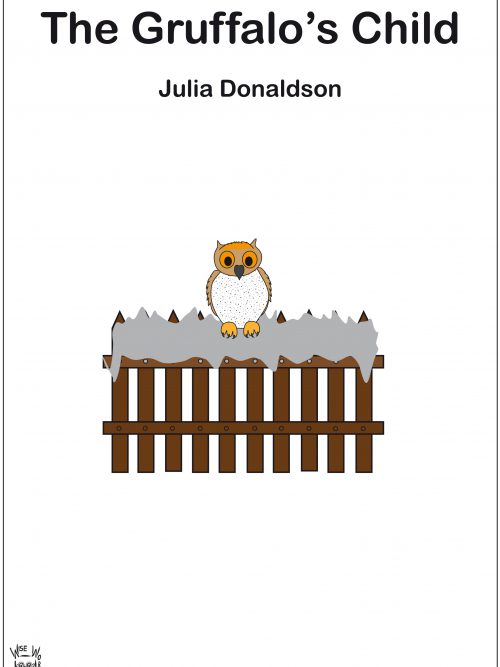 USING BOOKS TO ENHANCE A CHILD'S UNDERSTANDING AND INCREASE HIS/HER EXPRESSIVE LANGUAGE You can use a book to expand your child's • Vocabulary (boulder, trunk, basket, gleamed, log pile) • Understanding of concepts (bored, brave, wild) • Ability to understand questions Wise Words Scripts - offer clinicians, teachers and parents readily available questions designed specifically for each book. A script provides a variety of questions at each level of understanding for each page of the book. A teacher or clinician working with a group of children can tailor questions to each child's language ability. This script and other available scripts have been based on Marion Blank's Model of Classroom Language. Marion Blank recognised the importance of keeping questions and statements within a child’s level of understanding. The more concrete the statement or question, the easier it will be for the child to understand. As questions become more abstract, they become harder for children to answer. The Blank Model is divided into 4 levels of questioning, moving from the concrete (easiest) at Level 1 to the abstract (most difficult) at Level 4.
USING BOOKS TO ENHANCE A CHILD'S UNDERSTANDING AND INCREASE HIS/HER EXPRESSIVE LANGUAGE You can use a book to expand your child's • Vocabulary (boulder, trunk, basket, gleamed, log pile) • Understanding of concepts (bored, brave, wild) • Ability to understand questions Wise Words Scripts - offer clinicians, teachers and parents readily available questions designed specifically for each book. A script provides a variety of questions at each level of understanding for each page of the book. A teacher or clinician working with a group of children can tailor questions to each child's language ability. This script and other available scripts have been based on Marion Blank's Model of Classroom Language. Marion Blank recognised the importance of keeping questions and statements within a child’s level of understanding. The more concrete the statement or question, the easier it will be for the child to understand. As questions become more abstract, they become harder for children to answer. The Blank Model is divided into 4 levels of questioning, moving from the concrete (easiest) at Level 1 to the abstract (most difficult) at Level 4. -
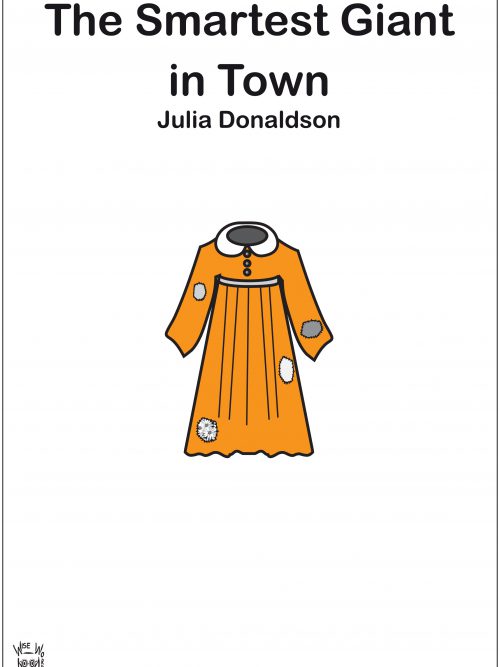 USING BOOKS TO ENHANCE A CHILD'S UNDERSTANDING AND INCREASE HIS/HER EXPRESSIVE LANGUAGE You can use a book to expand your child's • Vocabulary (magnificent, sail, squelchy, sniffing) • Understanding of concepts (cold, round, white, cosy, kind) • Ability to understand questions Wise Words Scripts - offer clinicians, teachers and parents readily available questions designed specifically for each book. A script provides a variety of questions at each level of understanding for each page of the book. A teacher or clinician working with a group of children can tailor questions to each child's language ability. This script and other available scripts have been based on Marion Blank's Model of Classroom Language. Marion Blank recognised the importance of keeping questions and statements within a child’s level of understanding. The more concrete the statement or question, the easier it will be for the child to understand. As questions become more abstract, they become harder for children to answer. The Blank Model is divided into 4 levels of questioning, moving from the concrete (easiest) at Level 1 to the abstract (most difficult) at Level 4.
USING BOOKS TO ENHANCE A CHILD'S UNDERSTANDING AND INCREASE HIS/HER EXPRESSIVE LANGUAGE You can use a book to expand your child's • Vocabulary (magnificent, sail, squelchy, sniffing) • Understanding of concepts (cold, round, white, cosy, kind) • Ability to understand questions Wise Words Scripts - offer clinicians, teachers and parents readily available questions designed specifically for each book. A script provides a variety of questions at each level of understanding for each page of the book. A teacher or clinician working with a group of children can tailor questions to each child's language ability. This script and other available scripts have been based on Marion Blank's Model of Classroom Language. Marion Blank recognised the importance of keeping questions and statements within a child’s level of understanding. The more concrete the statement or question, the easier it will be for the child to understand. As questions become more abstract, they become harder for children to answer. The Blank Model is divided into 4 levels of questioning, moving from the concrete (easiest) at Level 1 to the abstract (most difficult) at Level 4. -
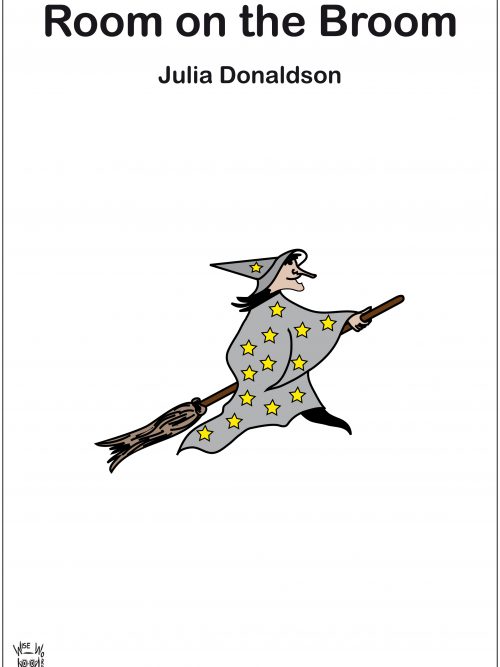 USING BOOKS TO ENHANCE A CHILD'S UNDERSTANDING AND INCREASE HIS/HER EXPRESSIVE LANGUAGE You can use a book to expand a child's • vocabulary (plait, beast, fluttered, cloak, cauldron, bog) • understanding of concepts (storm, tall, scary, clean, politely) • ability to understand questions Wise Words Scripts - offer clinicians, teachers and parents readily available questions designed specifically for each book. A script provides a variety of questions at each level of understanding for each page of the book. A teacher or clinician working with a group of children can tailor questions to each child's language ability. This script and other available scripts have been based on Marion Blank's Model of Classroom Language. Marion Blank recognised the importance of keeping questions and statements within a child’s level of understanding. The more concrete the statement or question, the easier it will be for the child to understand. As questions become more abstract, they become harder for children to answer. The Blank Model is divided into 4 levels of questioning, moving from the concrete (easiest) at Level 1 to the abstract (most difficult) at Level 4.
USING BOOKS TO ENHANCE A CHILD'S UNDERSTANDING AND INCREASE HIS/HER EXPRESSIVE LANGUAGE You can use a book to expand a child's • vocabulary (plait, beast, fluttered, cloak, cauldron, bog) • understanding of concepts (storm, tall, scary, clean, politely) • ability to understand questions Wise Words Scripts - offer clinicians, teachers and parents readily available questions designed specifically for each book. A script provides a variety of questions at each level of understanding for each page of the book. A teacher or clinician working with a group of children can tailor questions to each child's language ability. This script and other available scripts have been based on Marion Blank's Model of Classroom Language. Marion Blank recognised the importance of keeping questions and statements within a child’s level of understanding. The more concrete the statement or question, the easier it will be for the child to understand. As questions become more abstract, they become harder for children to answer. The Blank Model is divided into 4 levels of questioning, moving from the concrete (easiest) at Level 1 to the abstract (most difficult) at Level 4. -
Sale!
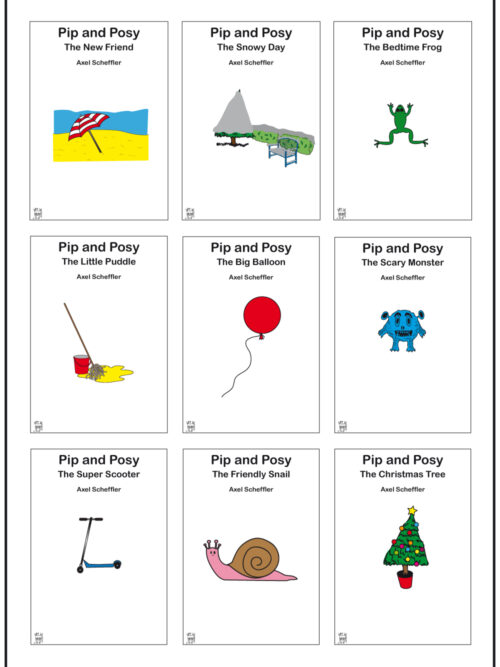 THE PIP & POSY TOTAL PACKAGE includes 9 books ... • Pip & Posy - The New Friend • Pip & Posy - The Snowy Day • Pip & Posy - The Little Puddle • Pip & Posy - The Bedtime Frog • Pip & Posy - The Big Balloon • Pip & Posy - The Scary Monster • Pip & Posy - The Super Scooter • Pip & Posy - The The Friendly Snail • Pip & Posy - The Christmas Tree These scripts have been based on Marion Blank's Model of Classroom Language. Marion Blank recognised the importance of keeping questions and statements within a child’s level of understanding. The more concrete the statement or question, the easier it will be for the child to understand. As questions become more abstract, they become harder for children to answer. The Blank Model is divided into 4 levels of questioning, moving from the concrete (easiest) at Level 1 to the abstract (most difficult) at Level 4.
THE PIP & POSY TOTAL PACKAGE includes 9 books ... • Pip & Posy - The New Friend • Pip & Posy - The Snowy Day • Pip & Posy - The Little Puddle • Pip & Posy - The Bedtime Frog • Pip & Posy - The Big Balloon • Pip & Posy - The Scary Monster • Pip & Posy - The Super Scooter • Pip & Posy - The The Friendly Snail • Pip & Posy - The Christmas Tree These scripts have been based on Marion Blank's Model of Classroom Language. Marion Blank recognised the importance of keeping questions and statements within a child’s level of understanding. The more concrete the statement or question, the easier it will be for the child to understand. As questions become more abstract, they become harder for children to answer. The Blank Model is divided into 4 levels of questioning, moving from the concrete (easiest) at Level 1 to the abstract (most difficult) at Level 4. -
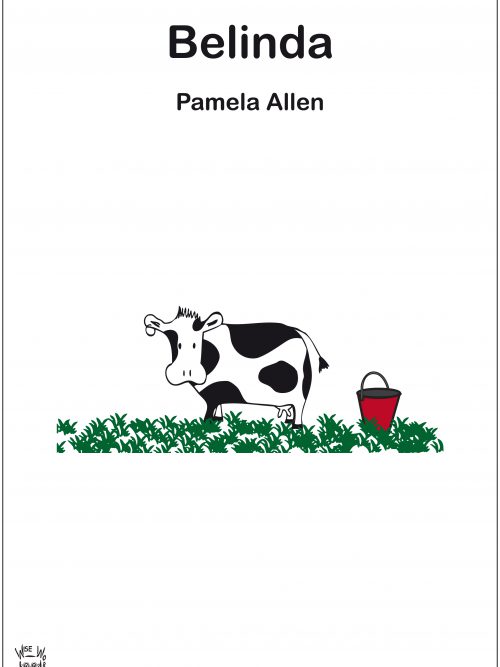 USING BOOKS TO ENHANCE A CHILD'S UNDERSTANDING AND INCREASE HIS/HER EXPRESSIVE LANGUAGE You can use a book to expand a child's • vocabulary (beetroot, paddock, trotting, rope, apron, disguise) • understanding of concepts (e.g. carefully, fattest, pretty, firmly) • ability to understand questions Wise Words Scripts - offer clinicians, teachers and parents readily available questions designed specifically for each book. A script provides a variety of questions at each level of understanding for each page of the book. A teacher or clinician working with a group of children can tailor questions to each child's language ability. This script and other available scripts have been based on Marion Blank's Model of Classroom Language. Marion Blank recognised the importance of keeping questions and statements within a child’s level of understanding. The more concrete the statement or question, the easier it will be for the child to understand. As questions become more abstract, they become harder for children to answer. The Blank Model is divided into 4 levels of questioning, moving from the concrete (easiest) at Level 1 to the abstract (most difficult) at Level 4.
USING BOOKS TO ENHANCE A CHILD'S UNDERSTANDING AND INCREASE HIS/HER EXPRESSIVE LANGUAGE You can use a book to expand a child's • vocabulary (beetroot, paddock, trotting, rope, apron, disguise) • understanding of concepts (e.g. carefully, fattest, pretty, firmly) • ability to understand questions Wise Words Scripts - offer clinicians, teachers and parents readily available questions designed specifically for each book. A script provides a variety of questions at each level of understanding for each page of the book. A teacher or clinician working with a group of children can tailor questions to each child's language ability. This script and other available scripts have been based on Marion Blank's Model of Classroom Language. Marion Blank recognised the importance of keeping questions and statements within a child’s level of understanding. The more concrete the statement or question, the easier it will be for the child to understand. As questions become more abstract, they become harder for children to answer. The Blank Model is divided into 4 levels of questioning, moving from the concrete (easiest) at Level 1 to the abstract (most difficult) at Level 4. -
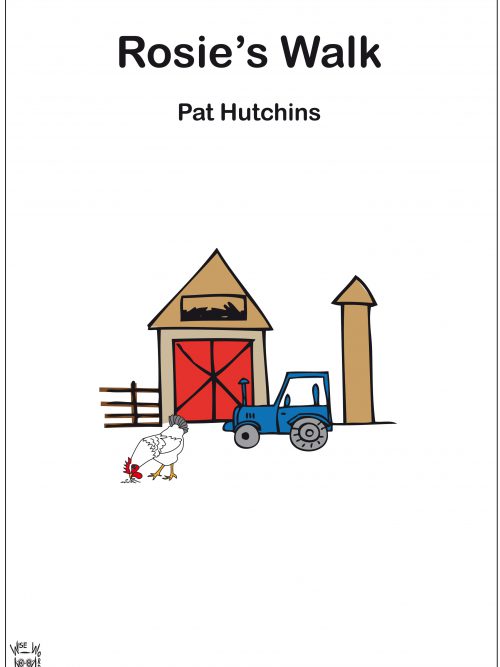 USING BOOKS TO ENHANCE A CHILD'S UNDERSTANDING AND INCREASE HIS/HER EXPRESSIVE LANGUAGE You can use a book to expand a child's • vocabulary (pond, fox, goat, windmill, jumped, stinging) • understanding of concepts (e.g. wet, heavy, light, white, many, through) • ability to understand questions Wise Words Scripts - offer clinicians, teachers and parents readily available questions designed specifically for each book. A script provides a variety of questions at each level of understanding for each page of the book. A teacher or clinician working with a group of children can tailor questions to each child's language ability. This script and other available scripts have been based on Marion Blank's Model of Classroom Language. Marion Blank recognised the importance of keeping questions and statements within a child’s level of understanding. The more concrete the statement or question, the easier it will be for the child to understand. As questions become more abstract, they become harder for children to answer. The Blank Model is divided into 4 levels of questioning, moving from the concrete (easiest) at Level 1 to the abstract (most difficult) at Level 4.
USING BOOKS TO ENHANCE A CHILD'S UNDERSTANDING AND INCREASE HIS/HER EXPRESSIVE LANGUAGE You can use a book to expand a child's • vocabulary (pond, fox, goat, windmill, jumped, stinging) • understanding of concepts (e.g. wet, heavy, light, white, many, through) • ability to understand questions Wise Words Scripts - offer clinicians, teachers and parents readily available questions designed specifically for each book. A script provides a variety of questions at each level of understanding for each page of the book. A teacher or clinician working with a group of children can tailor questions to each child's language ability. This script and other available scripts have been based on Marion Blank's Model of Classroom Language. Marion Blank recognised the importance of keeping questions and statements within a child’s level of understanding. The more concrete the statement or question, the easier it will be for the child to understand. As questions become more abstract, they become harder for children to answer. The Blank Model is divided into 4 levels of questioning, moving from the concrete (easiest) at Level 1 to the abstract (most difficult) at Level 4. -
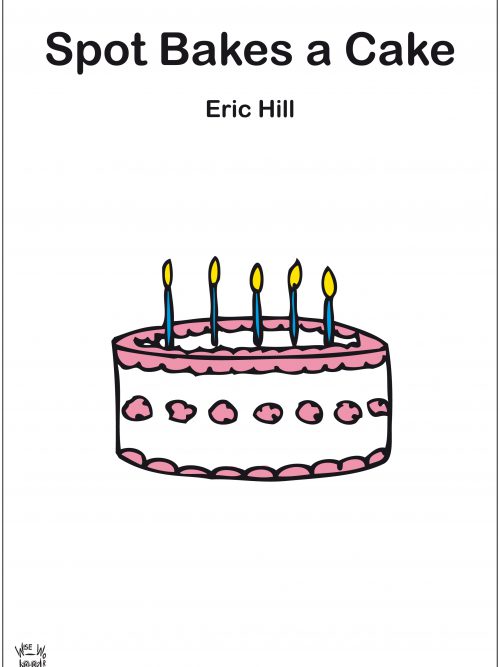 USING BOOKS TO ENHANCE A CHILD'S UNDERSTANDING AND INCREASE HIS/HER EXPRESSIVE LANGUAGE You can use a book to expand a child's • Vocabulary (calendar, trolley, bowl, apron, shopping, mixing, drawing) • Understanding of concepts (messy, sticky, many, hot, delicious) • Ability to understand questions Wise Words Scripts - offer clinicians, teachers and parents readily available questions designed specifically for each book. A script provides a variety of questions at each level of understanding for each page of the book. A teacher or clinician working with a group of children can tailor questions to each child's language ability. This script and other available scripts have been based on Marion Blank's Model of Classroom Language. Marion Blank recognised the importance of keeping questions and statements within a child’s level of understanding. The more concrete the statement or question, the easier it will be for the child to understand. As questions become more abstract, they become harder for children to answer. The Blank Model is divided into 4 levels of questioning, moving from the concrete (easiest) at Level 1 to the abstract (most difficult) at Level 4.
USING BOOKS TO ENHANCE A CHILD'S UNDERSTANDING AND INCREASE HIS/HER EXPRESSIVE LANGUAGE You can use a book to expand a child's • Vocabulary (calendar, trolley, bowl, apron, shopping, mixing, drawing) • Understanding of concepts (messy, sticky, many, hot, delicious) • Ability to understand questions Wise Words Scripts - offer clinicians, teachers and parents readily available questions designed specifically for each book. A script provides a variety of questions at each level of understanding for each page of the book. A teacher or clinician working with a group of children can tailor questions to each child's language ability. This script and other available scripts have been based on Marion Blank's Model of Classroom Language. Marion Blank recognised the importance of keeping questions and statements within a child’s level of understanding. The more concrete the statement or question, the easier it will be for the child to understand. As questions become more abstract, they become harder for children to answer. The Blank Model is divided into 4 levels of questioning, moving from the concrete (easiest) at Level 1 to the abstract (most difficult) at Level 4. -
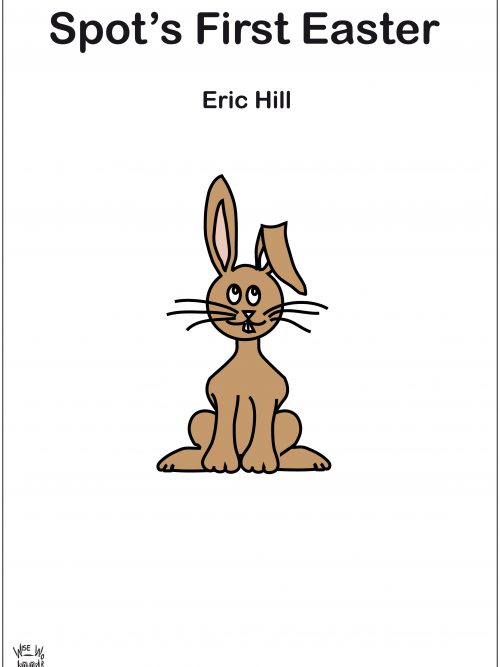 USING BOOKS TO ENHANCE A CHILD'S UNDERSTANDING AND INCREASE HIS/HER EXPRESSIVE LANGUAGE You can use a book to expand a child's • Vocabulary (basket, trowel, snail, finding, bench, sack, core) • Understanding of concepts (under, hungry, angry, behind, crunchy, finished, broken) • Ability to understand questions Wise Words Scripts - offer clinicians, teachers and parents readily available questions designed specifically for each book. A script provides a variety of questions at each level of understanding for each page of the book. A teacher or clinician working with a group of children can tailor questions to each child's language ability. This script and other available scripts have been based on Marion Blank's Model of Classroom Language. Marion Blank recognised the importance of keeping questions and statements within a child’s level of understanding. The more concrete the statement or question, the easier it will be for the child to understand. As questions become more abstract, they become harder for children to answer. The Blank Model is divided into 4 levels of questioning, moving from the concrete (easiest) at Level 1 to the abstract (most difficult) at Level 4.
USING BOOKS TO ENHANCE A CHILD'S UNDERSTANDING AND INCREASE HIS/HER EXPRESSIVE LANGUAGE You can use a book to expand a child's • Vocabulary (basket, trowel, snail, finding, bench, sack, core) • Understanding of concepts (under, hungry, angry, behind, crunchy, finished, broken) • Ability to understand questions Wise Words Scripts - offer clinicians, teachers and parents readily available questions designed specifically for each book. A script provides a variety of questions at each level of understanding for each page of the book. A teacher or clinician working with a group of children can tailor questions to each child's language ability. This script and other available scripts have been based on Marion Blank's Model of Classroom Language. Marion Blank recognised the importance of keeping questions and statements within a child’s level of understanding. The more concrete the statement or question, the easier it will be for the child to understand. As questions become more abstract, they become harder for children to answer. The Blank Model is divided into 4 levels of questioning, moving from the concrete (easiest) at Level 1 to the abstract (most difficult) at Level 4. -
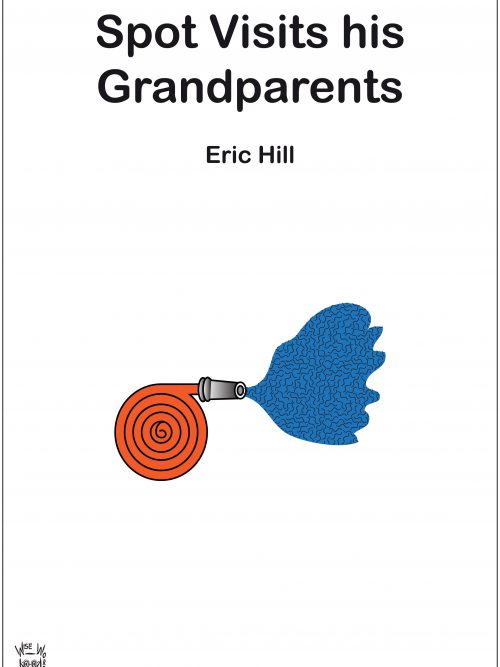 USING BOOKS TO ENHANCE A CHILD'S UNDERSTANDING AND INCREASE HIS/HER EXPRESSIVE LANGUAGE You can use a book to expand a child's • vocabulary (grandparents, shovel, garden fork, spray, eggs, visiting, picking) • understanding of concepts (e..g wet, hidden, broken, hot, comfortable) • ability to understand questions Wise Words Scripts - offer clinicians, teachers and parents readily available questions designed specifically for each book. A script provides a variety of questions at each level of understanding for each page of the book. A teacher or clinician working with a group of children can tailor questions to each child's language ability. This script and other available scripts have been based on Marion Blank's Model of Classroom Language. Marion Blank recognised the importance of keeping questions and statements within a child’s level of understanding. The more concrete the statement or question, the easier it will be for the child to understand. As questions become more abstract, they become harder for children to answer. The Blank Model is divided into 4 levels of questioning, moving from the concrete (easiest) at Level 1 to the abstract (most difficult) at Level 4.
USING BOOKS TO ENHANCE A CHILD'S UNDERSTANDING AND INCREASE HIS/HER EXPRESSIVE LANGUAGE You can use a book to expand a child's • vocabulary (grandparents, shovel, garden fork, spray, eggs, visiting, picking) • understanding of concepts (e..g wet, hidden, broken, hot, comfortable) • ability to understand questions Wise Words Scripts - offer clinicians, teachers and parents readily available questions designed specifically for each book. A script provides a variety of questions at each level of understanding for each page of the book. A teacher or clinician working with a group of children can tailor questions to each child's language ability. This script and other available scripts have been based on Marion Blank's Model of Classroom Language. Marion Blank recognised the importance of keeping questions and statements within a child’s level of understanding. The more concrete the statement or question, the easier it will be for the child to understand. As questions become more abstract, they become harder for children to answer. The Blank Model is divided into 4 levels of questioning, moving from the concrete (easiest) at Level 1 to the abstract (most difficult) at Level 4. -
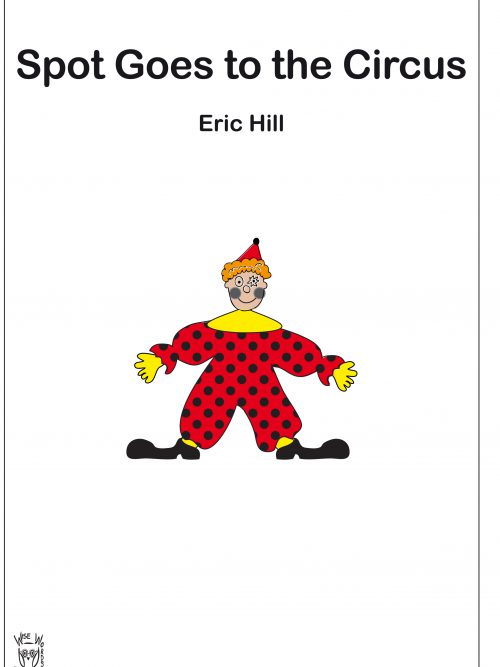 USING BOOKS TO ENHANCE A CHILD'S UNDERSTANDING AND INCREASE HIS/HER EXPRESSIVE LANGUAGE You can use a book to expand a child's • vocabulary (lion, trapeze, cage, balancing, circus, swinging) • understanding of concepts (e.g. high, difficult, scary, easy, large) • ability to understand questions Wise Words Scripts - offer clinicians, teachers and parents readily available questions designed specifically for each book. A script provides a variety of questions at each level of understanding for each page of the book. A teacher or clinician working with a group of children can tailor questions to each child's language ability. This script and other available scripts have been based on Marion Blank's Model of Classroom Language. Marion Blank recognised the importance of keeping questions and statements within a child’s level of understanding. The more concrete the statement or question, the easier it will be for the child to understand. As questions become more abstract, they become harder for children to answer. The Blank Model is divided into 4 levels of questioning, moving from the concrete (easiest) at Level 1 to the abstract (most difficult) at Level 4.
USING BOOKS TO ENHANCE A CHILD'S UNDERSTANDING AND INCREASE HIS/HER EXPRESSIVE LANGUAGE You can use a book to expand a child's • vocabulary (lion, trapeze, cage, balancing, circus, swinging) • understanding of concepts (e.g. high, difficult, scary, easy, large) • ability to understand questions Wise Words Scripts - offer clinicians, teachers and parents readily available questions designed specifically for each book. A script provides a variety of questions at each level of understanding for each page of the book. A teacher or clinician working with a group of children can tailor questions to each child's language ability. This script and other available scripts have been based on Marion Blank's Model of Classroom Language. Marion Blank recognised the importance of keeping questions and statements within a child’s level of understanding. The more concrete the statement or question, the easier it will be for the child to understand. As questions become more abstract, they become harder for children to answer. The Blank Model is divided into 4 levels of questioning, moving from the concrete (easiest) at Level 1 to the abstract (most difficult) at Level 4. -
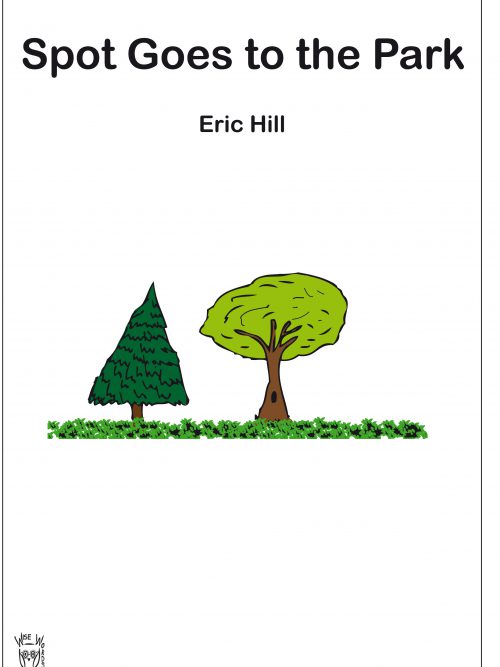 USING BOOKS TO ENHANCE A CHILD'S UNDERSTANDING AND INCREASE HIS/HER EXPRESSIVE LANGUAGE You can use a book to expand a child's • vocabulary (park, cards, wagging, looking, gate, scaring, newspaper) • understanding of concepts (e.g. accident, high, over, grateful, frightened) • ability to understand questions Wise Words Scripts - offer clinicians, teachers and parents readily available questions designed specifically for each book. A script provides a variety of questions at each level of understanding for each page of the book. A teacher or clinician working with a group of children can tailor questions to each child's language ability. This script and other available scripts have been based on Marion Blank's Model of Classroom Language. Marion Blank recognised the importance of keeping questions and statements within a child’s level of understanding. The more concrete the statement or question, the easier it will be for the child to understand. As questions become more abstract, they become harder for children to answer. The Blank Model is divided into 4 levels of questioning, moving from the concrete (easiest) at Level 1 to the abstract (most difficult) at Level 4.
USING BOOKS TO ENHANCE A CHILD'S UNDERSTANDING AND INCREASE HIS/HER EXPRESSIVE LANGUAGE You can use a book to expand a child's • vocabulary (park, cards, wagging, looking, gate, scaring, newspaper) • understanding of concepts (e.g. accident, high, over, grateful, frightened) • ability to understand questions Wise Words Scripts - offer clinicians, teachers and parents readily available questions designed specifically for each book. A script provides a variety of questions at each level of understanding for each page of the book. A teacher or clinician working with a group of children can tailor questions to each child's language ability. This script and other available scripts have been based on Marion Blank's Model of Classroom Language. Marion Blank recognised the importance of keeping questions and statements within a child’s level of understanding. The more concrete the statement or question, the easier it will be for the child to understand. As questions become more abstract, they become harder for children to answer. The Blank Model is divided into 4 levels of questioning, moving from the concrete (easiest) at Level 1 to the abstract (most difficult) at Level 4. -
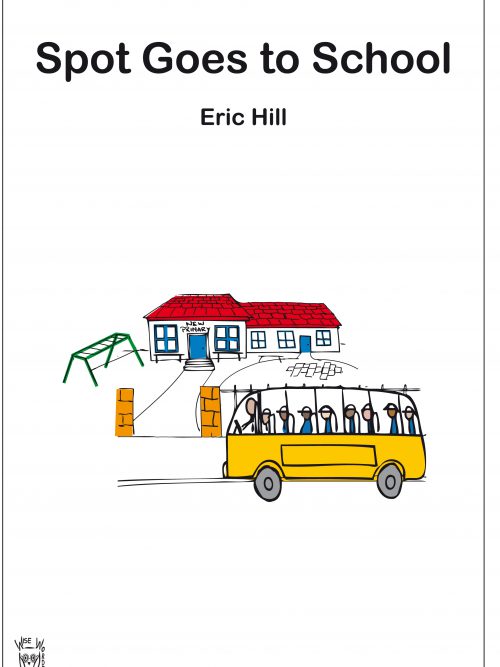 USING BOOKS TO ENHANCE A CHILD'S UNDERSTANDING AND INCREASE HIS/HER EXPRESSIVE LANGUAGE You can use a book to expand a child's • vocabulary (easel, paints, bell, singing, drawing, cubby house, chimney) • understanding of concepts (e.g. sad, prickly, up, under, heavy, mess) • ability to understand questions Wise Words Scripts - offer clinicians, teachers and parents readily available questions designed specifically for each book. A script provides a variety of questions at each level of understanding for each page of the book. A teacher or clinician working with a group of children can tailor questions to each child's language ability. This script and other available scripts have been based on Marion Blank's Model of Classroom Language. Marion Blank recognised the importance of keeping questions and statements within a child’s level of understanding. The more concrete the statement or question, the easier it will be for the child to understand. As questions become more abstract, they become harder for children to answer. The Blank Model is divided into 4 levels of questioning, moving from the concrete (easiest) at Level 1 to the abstract (most difficult) at Level 4.
USING BOOKS TO ENHANCE A CHILD'S UNDERSTANDING AND INCREASE HIS/HER EXPRESSIVE LANGUAGE You can use a book to expand a child's • vocabulary (easel, paints, bell, singing, drawing, cubby house, chimney) • understanding of concepts (e.g. sad, prickly, up, under, heavy, mess) • ability to understand questions Wise Words Scripts - offer clinicians, teachers and parents readily available questions designed specifically for each book. A script provides a variety of questions at each level of understanding for each page of the book. A teacher or clinician working with a group of children can tailor questions to each child's language ability. This script and other available scripts have been based on Marion Blank's Model of Classroom Language. Marion Blank recognised the importance of keeping questions and statements within a child’s level of understanding. The more concrete the statement or question, the easier it will be for the child to understand. As questions become more abstract, they become harder for children to answer. The Blank Model is divided into 4 levels of questioning, moving from the concrete (easiest) at Level 1 to the abstract (most difficult) at Level 4. -
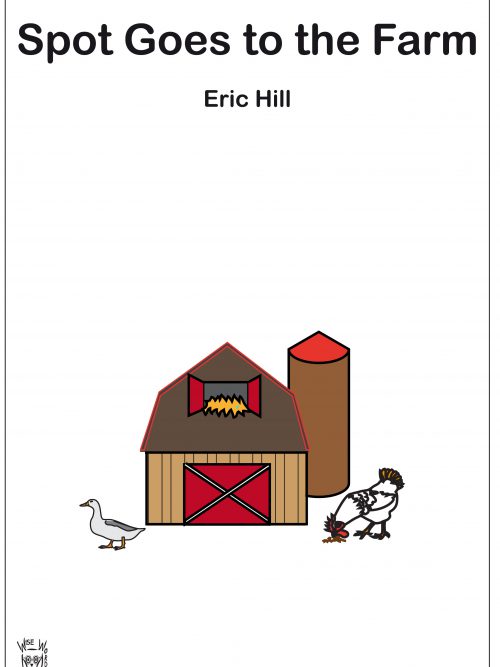 USING BOOKS TO ENHANCE A CHILD'S UNDERSTANDING AND INCREASE HIS/HER EXPRESSIVE LANGUAGE You can use a book to expand a child's • vocabulary (tractor, driving, wheels, stable, bucket, straw, sheep, pegs) • understanding of concepts (e.g. wet, dry, soft, behind, in) • ability to understand questions Wise Words Scripts - offer clinicians, teachers and parents readily available questions designed specifically for each book. A script provides a variety of questions at each level of understanding for each page of the book. A teacher or clinician working with a group of children can tailor questions to each child's language ability. This script and other available scripts have been based on Marion Blank's Model of Classroom Language. Marion Blank recognised the importance of keeping questions and statements within a child’s level of understanding. The more concrete the statement or question, the easier it will be for the child to understand. As questions become more abstract, they become harder for children to answer. The Blank Model is divided into 4 levels of questioning, moving from the concrete (easiest) at Level 1 to the abstract (most difficult) at Level 4.
USING BOOKS TO ENHANCE A CHILD'S UNDERSTANDING AND INCREASE HIS/HER EXPRESSIVE LANGUAGE You can use a book to expand a child's • vocabulary (tractor, driving, wheels, stable, bucket, straw, sheep, pegs) • understanding of concepts (e.g. wet, dry, soft, behind, in) • ability to understand questions Wise Words Scripts - offer clinicians, teachers and parents readily available questions designed specifically for each book. A script provides a variety of questions at each level of understanding for each page of the book. A teacher or clinician working with a group of children can tailor questions to each child's language ability. This script and other available scripts have been based on Marion Blank's Model of Classroom Language. Marion Blank recognised the importance of keeping questions and statements within a child’s level of understanding. The more concrete the statement or question, the easier it will be for the child to understand. As questions become more abstract, they become harder for children to answer. The Blank Model is divided into 4 levels of questioning, moving from the concrete (easiest) at Level 1 to the abstract (most difficult) at Level 4. -
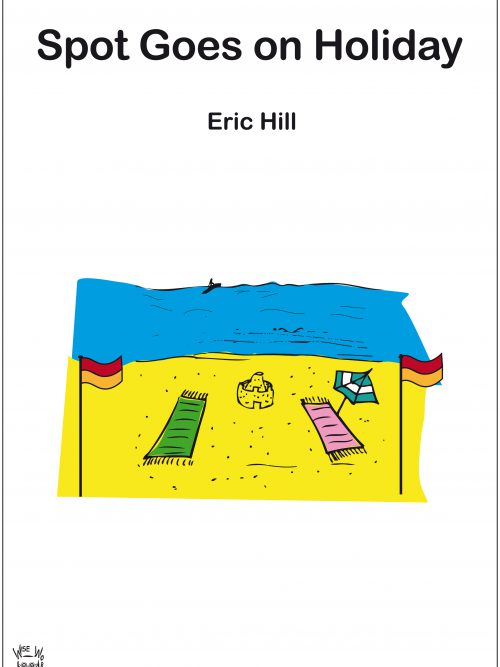 USING BOOKS TO ENHANCE A CHILD'S UNDERSTANDING AND INCREASE HIS/HER EXPRESSIVE LANGUAGE You can use a book to expand a child's • Vocabulary (seagull, beach, towel, fishing net, wave, rowing) • Understanding of concepts (wet, sandy, angry) • Ability to understand questions Wise Words Scripts - offer clinicians, teachers and parents readily available questions designed specifically for each book. A script provides a variety of questions at each level of understanding for each page of the book. A teacher or clinician working with a group of children can tailor questions to each child's language ability. This script and other available scripts have been based on Marion Blank's Model of Classroom Language. Marion Blank recognised the importance of keeping questions and statements within a child’s level of understanding. The more concrete the statement or question, the easier it will be for the child to understand. As questions become more abstract, they become harder for children to answer. The Blank Model is divided into 4 levels of questioning, moving from the concrete (easiest) at Level 1 to the abstract (most difficult) at Level 4.
USING BOOKS TO ENHANCE A CHILD'S UNDERSTANDING AND INCREASE HIS/HER EXPRESSIVE LANGUAGE You can use a book to expand a child's • Vocabulary (seagull, beach, towel, fishing net, wave, rowing) • Understanding of concepts (wet, sandy, angry) • Ability to understand questions Wise Words Scripts - offer clinicians, teachers and parents readily available questions designed specifically for each book. A script provides a variety of questions at each level of understanding for each page of the book. A teacher or clinician working with a group of children can tailor questions to each child's language ability. This script and other available scripts have been based on Marion Blank's Model of Classroom Language. Marion Blank recognised the importance of keeping questions and statements within a child’s level of understanding. The more concrete the statement or question, the easier it will be for the child to understand. As questions become more abstract, they become harder for children to answer. The Blank Model is divided into 4 levels of questioning, moving from the concrete (easiest) at Level 1 to the abstract (most difficult) at Level 4. -
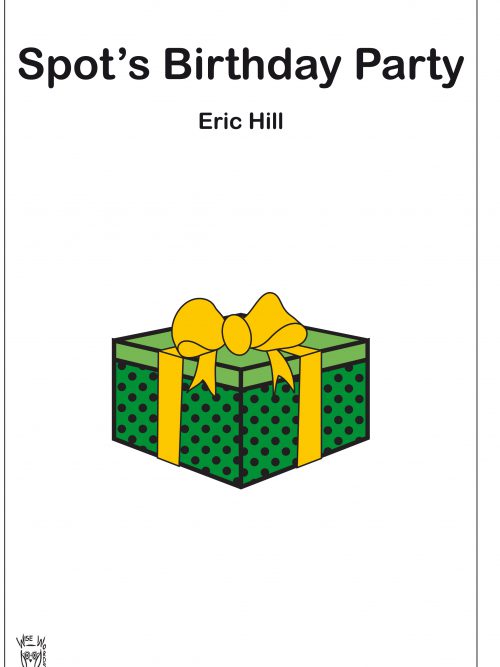 USING BOOKS TO ENHANCE A CHILD'S UNDERSTANDING AND INCREASE HIS/HER EXPRESSIVE LANGUAGE You can use a book to expand a child's • vocabulary (crocodile, lamp, crown, curtain, jelly, lead, umbrella) • understanding of concepts (e.g. loud, large, under, round, messy) • ability to understand questions Wise Words Scripts - offer clinicians, teachers and parents readily available questions designed specifically for each book. A script provides a variety of questions at each level of understanding for each page of the book. A teacher or clinician working with a group of children can tailor questions to each child's language ability. This script and other available scripts have been based on Marion Blank's Model of Classroom Language. Marion Blank recognised the importance of keeping questions and statements within a child’s level of understanding. The more concrete the statement or question, the easier it will be for the child to understand. As questions become more abstract, they become harder for children to answer. The Blank Model is divided into 4 levels of questioning, moving from the concrete (easiest) at Level 1 to the abstract (most difficult) at Level 4.
USING BOOKS TO ENHANCE A CHILD'S UNDERSTANDING AND INCREASE HIS/HER EXPRESSIVE LANGUAGE You can use a book to expand a child's • vocabulary (crocodile, lamp, crown, curtain, jelly, lead, umbrella) • understanding of concepts (e.g. loud, large, under, round, messy) • ability to understand questions Wise Words Scripts - offer clinicians, teachers and parents readily available questions designed specifically for each book. A script provides a variety of questions at each level of understanding for each page of the book. A teacher or clinician working with a group of children can tailor questions to each child's language ability. This script and other available scripts have been based on Marion Blank's Model of Classroom Language. Marion Blank recognised the importance of keeping questions and statements within a child’s level of understanding. The more concrete the statement or question, the easier it will be for the child to understand. As questions become more abstract, they become harder for children to answer. The Blank Model is divided into 4 levels of questioning, moving from the concrete (easiest) at Level 1 to the abstract (most difficult) at Level 4. -
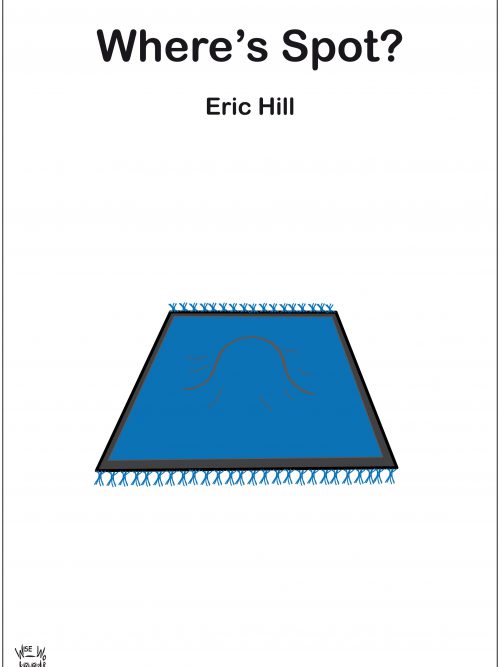 USING BOOKS TO ENHANCE A CHILD'S UNDERSTANDING AND INCREASE HIS/HER EXPRESSIVE LANGUAGE You can use a book to expand a child's • vocabulary (honey, clock, piano, hippo, eating, racing, basket, rug) • understanding of concepts (e.g. empty, hungry, under, in, naughty) • ability to understand questions Wise Words Scripts - offer clinicians, teachers and parents readily available questions designed specifically for each book. A script provides a variety of questions at each level of understanding for each page of the book. A teacher or clinician working with a group of children can tailor questions to each child's language ability. This script and other available scripts have been based on Marion Blank's Model of Classroom Language. Marion Blank recognised the importance of keeping questions and statements within a child’s level of understanding. The more concrete the statement or question, the easier it will be for the child to understand. As questions become more abstract, they become harder for children to answer. The Blank Model is divided into 4 levels of questioning, moving from the concrete (easiest) at Level 1 to the abstract (most difficult) at Level 4.
USING BOOKS TO ENHANCE A CHILD'S UNDERSTANDING AND INCREASE HIS/HER EXPRESSIVE LANGUAGE You can use a book to expand a child's • vocabulary (honey, clock, piano, hippo, eating, racing, basket, rug) • understanding of concepts (e.g. empty, hungry, under, in, naughty) • ability to understand questions Wise Words Scripts - offer clinicians, teachers and parents readily available questions designed specifically for each book. A script provides a variety of questions at each level of understanding for each page of the book. A teacher or clinician working with a group of children can tailor questions to each child's language ability. This script and other available scripts have been based on Marion Blank's Model of Classroom Language. Marion Blank recognised the importance of keeping questions and statements within a child’s level of understanding. The more concrete the statement or question, the easier it will be for the child to understand. As questions become more abstract, they become harder for children to answer. The Blank Model is divided into 4 levels of questioning, moving from the concrete (easiest) at Level 1 to the abstract (most difficult) at Level 4. -
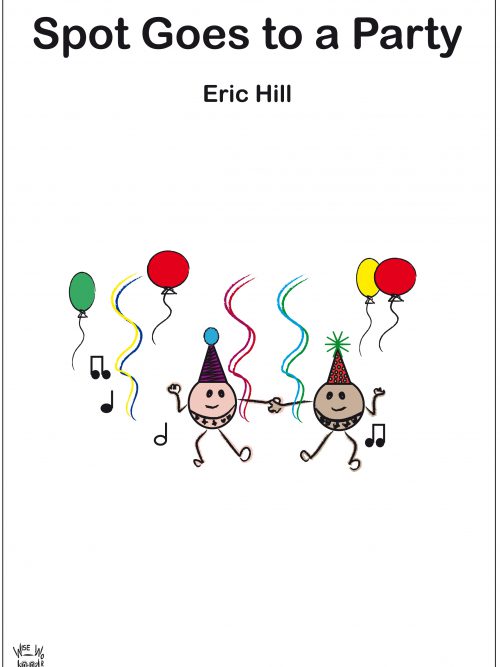 USING BOOKS TO ENHANCE A CHILD'S UNDERSTANDING AND INCREASE HIS/HER EXPRESSIVE LANGUAGE You can use a book to expand a child's • vocabulary (invitation, balloons, riding, dancing, horse) • understanding of concepts (e.g. inside, under, surprised, all) • ability to understand questions Wise Words Scripts - offer clinicians, teachers and parents readily available questions designed specifically for each book. A script provides a variety of questions at each level of understanding for each page of the book. A teacher or clinician working with a group of children can tailor questions to each child's language ability. This script and other available scripts have been based on Marion Blank's Model of Classroom Language. Marion Blank recognised the importance of keeping questions and statements within a child’s level of understanding. The more concrete the statement or question, the easier it will be for the child to understand. As questions become more abstract, they become harder for children to answer. The Blank Model is divided into 4 levels of questioning, moving from the concrete (easiest) at Level 1 to the abstract (most difficult) at Level 4.
USING BOOKS TO ENHANCE A CHILD'S UNDERSTANDING AND INCREASE HIS/HER EXPRESSIVE LANGUAGE You can use a book to expand a child's • vocabulary (invitation, balloons, riding, dancing, horse) • understanding of concepts (e.g. inside, under, surprised, all) • ability to understand questions Wise Words Scripts - offer clinicians, teachers and parents readily available questions designed specifically for each book. A script provides a variety of questions at each level of understanding for each page of the book. A teacher or clinician working with a group of children can tailor questions to each child's language ability. This script and other available scripts have been based on Marion Blank's Model of Classroom Language. Marion Blank recognised the importance of keeping questions and statements within a child’s level of understanding. The more concrete the statement or question, the easier it will be for the child to understand. As questions become more abstract, they become harder for children to answer. The Blank Model is divided into 4 levels of questioning, moving from the concrete (easiest) at Level 1 to the abstract (most difficult) at Level 4. -
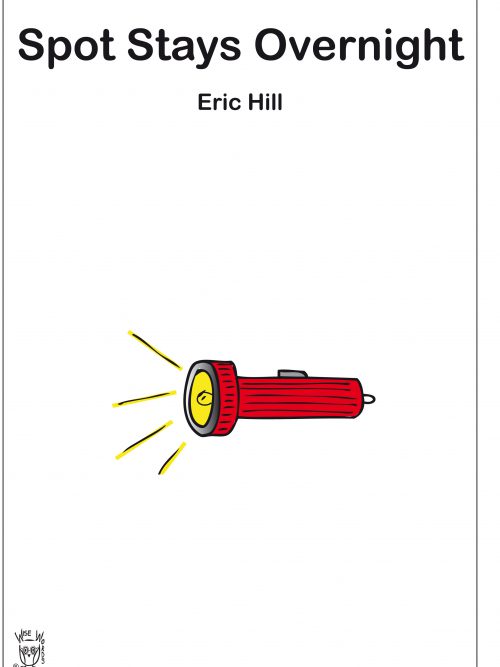 USING BOOKS TO ENHANCE A CHILD'S UNDERSTANDING AND INCREASE HIS/HER EXPRESSIVE LANGUAGE You can use a book to expand a child's • vocabulary (binoculars, torch, branch, sleeping bag, swinging, sliding) • understanding of concepts (e.g. favourite, slippery, high, tired, late) • ability to understand questions Wise Words Scripts - offer clinicians, teachers and parents readily available questions designed specifically for each book. A script provides a variety of questions at each level of understanding for each page of the book. A teacher or clinician working with a group of children can tailor questions to each child's language ability. This script and other available scripts have been based on Marion Blank's Model of Classroom Language. Marion Blank recognised the importance of keeping questions and statements within a child’s level of understanding. The more concrete the statement or question, the easier it will be for the child to understand. As questions become more abstract, they become harder for children to answer. The Blank Model is divided into 4 levels of questioning, moving from the concrete (easiest) at Level 1 to the abstract (most difficult) at Level 4.
USING BOOKS TO ENHANCE A CHILD'S UNDERSTANDING AND INCREASE HIS/HER EXPRESSIVE LANGUAGE You can use a book to expand a child's • vocabulary (binoculars, torch, branch, sleeping bag, swinging, sliding) • understanding of concepts (e.g. favourite, slippery, high, tired, late) • ability to understand questions Wise Words Scripts - offer clinicians, teachers and parents readily available questions designed specifically for each book. A script provides a variety of questions at each level of understanding for each page of the book. A teacher or clinician working with a group of children can tailor questions to each child's language ability. This script and other available scripts have been based on Marion Blank's Model of Classroom Language. Marion Blank recognised the importance of keeping questions and statements within a child’s level of understanding. The more concrete the statement or question, the easier it will be for the child to understand. As questions become more abstract, they become harder for children to answer. The Blank Model is divided into 4 levels of questioning, moving from the concrete (easiest) at Level 1 to the abstract (most difficult) at Level 4. -
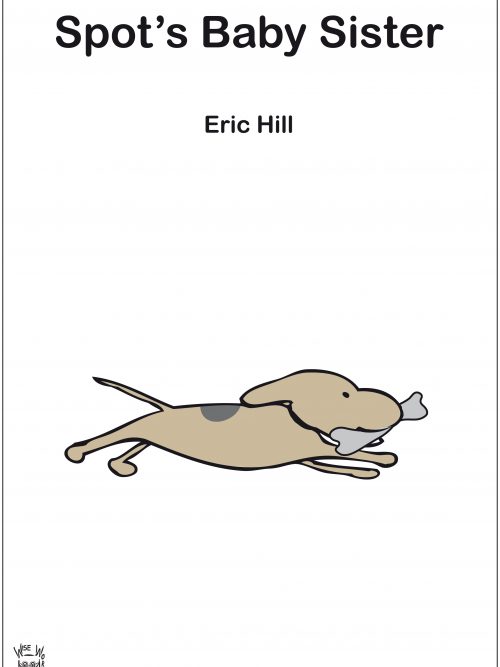 USING BOOKS TO ENHANCE A CHILD'S UNDERSTANDING AND INCREASE HIS/HER EXPRESSIVE LANGUAGE You can use a book to expand a child's • Vocabulary (armchair, bone, running, hiding, searching) • Understanding of concepts (e.g. tired, naughty, under) • Ability to understand questions Wise Words Scripts - offer clinicians, teachers and parents readily available questions designed specifically for each book. A script provides a variety of questions at each level of understanding for each page of the book. A teacher or clinician working with a group of children can tailor questions to each child's language ability. This script and other available scripts have been based on Marion Blank's Model of Classroom Language. Marion Blank recognised the importance of keeping questions and statements within a child’s level of understanding. The more concrete the statement or question, the easier it will be for the child to understand. As questions become more abstract, they become harder for children to answer. The Blank Model is divided into 4 levels of questioning, moving from the concrete (easiest) at Level 1 to the abstract (most difficult) at Level 4.
USING BOOKS TO ENHANCE A CHILD'S UNDERSTANDING AND INCREASE HIS/HER EXPRESSIVE LANGUAGE You can use a book to expand a child's • Vocabulary (armchair, bone, running, hiding, searching) • Understanding of concepts (e.g. tired, naughty, under) • Ability to understand questions Wise Words Scripts - offer clinicians, teachers and parents readily available questions designed specifically for each book. A script provides a variety of questions at each level of understanding for each page of the book. A teacher or clinician working with a group of children can tailor questions to each child's language ability. This script and other available scripts have been based on Marion Blank's Model of Classroom Language. Marion Blank recognised the importance of keeping questions and statements within a child’s level of understanding. The more concrete the statement or question, the easier it will be for the child to understand. As questions become more abstract, they become harder for children to answer. The Blank Model is divided into 4 levels of questioning, moving from the concrete (easiest) at Level 1 to the abstract (most difficult) at Level 4. -
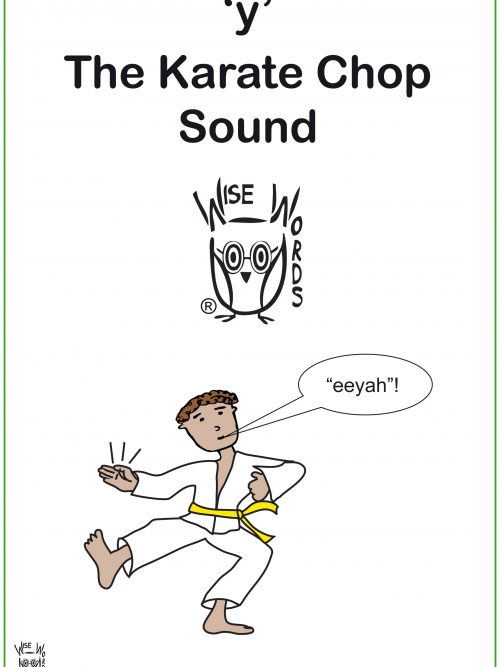 Y - The Karate Chop Sound Wise Words Articulation Programs - support clinicians, teachers and parents to establish 'new' (correct) sounds into their child's speech. Each program supplies detailed instructions for every task and game. The instructions have been written in a clear manner for a non-professional to follow. Numerous games are provided. These games have been designed to be fun and interactive and will ensure that the child remains engaged and compliant. Playing the games will help the child to generalise the ‘new’ sound into their everyday speech.
Y - The Karate Chop Sound Wise Words Articulation Programs - support clinicians, teachers and parents to establish 'new' (correct) sounds into their child's speech. Each program supplies detailed instructions for every task and game. The instructions have been written in a clear manner for a non-professional to follow. Numerous games are provided. These games have been designed to be fun and interactive and will ensure that the child remains engaged and compliant. Playing the games will help the child to generalise the ‘new’ sound into their everyday speech. -
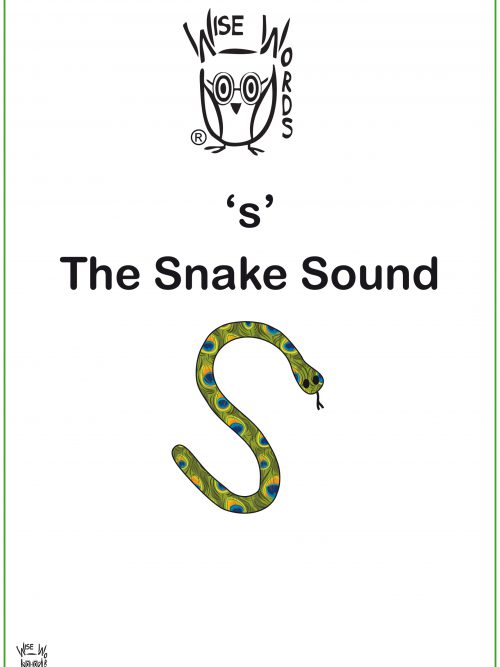 Wise Words Articulation Programs - support clinicians, teachers and parents to establish 'new' (correct) sounds into their child's speech. Each program supplies detailed instructions for every task and game. The instructions have been written in a clear manner for a non-professional to follow. Numerous games are provided. These games have been designed to be fun and interactive and will ensure that the child remains engaged and compliant. Playing the games will help the child to generalise the ‘new’ sound into their everyday speech.
Wise Words Articulation Programs - support clinicians, teachers and parents to establish 'new' (correct) sounds into their child's speech. Each program supplies detailed instructions for every task and game. The instructions have been written in a clear manner for a non-professional to follow. Numerous games are provided. These games have been designed to be fun and interactive and will ensure that the child remains engaged and compliant. Playing the games will help the child to generalise the ‘new’ sound into their everyday speech. -
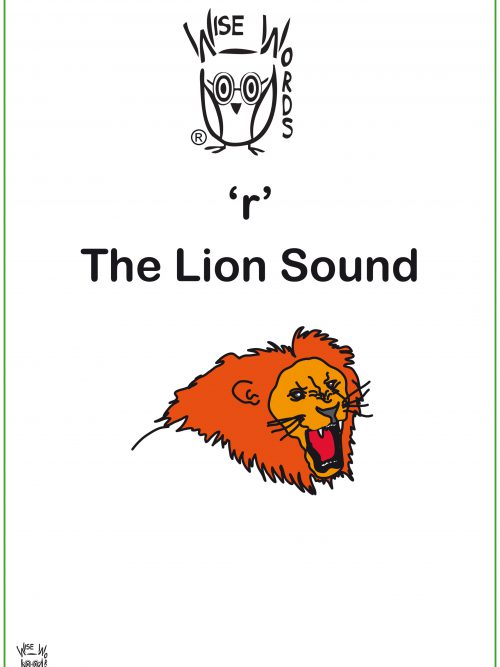 Wise Words Articulation Programs - support clinicians, teachers and parents to establish 'new' (correct) sounds into their child's speech. Each program supplies detailed instructions for every task and game. The instructions have been written in a clear manner for a non-professional to follow. Numerous games are provided. These games have been designed to be fun and interactive and will ensure that the child remains engaged and compliant. Playing the games will help the child to generalise the ‘new’ sound into their everyday speech..
Wise Words Articulation Programs - support clinicians, teachers and parents to establish 'new' (correct) sounds into their child's speech. Each program supplies detailed instructions for every task and game. The instructions have been written in a clear manner for a non-professional to follow. Numerous games are provided. These games have been designed to be fun and interactive and will ensure that the child remains engaged and compliant. Playing the games will help the child to generalise the ‘new’ sound into their everyday speech.. -
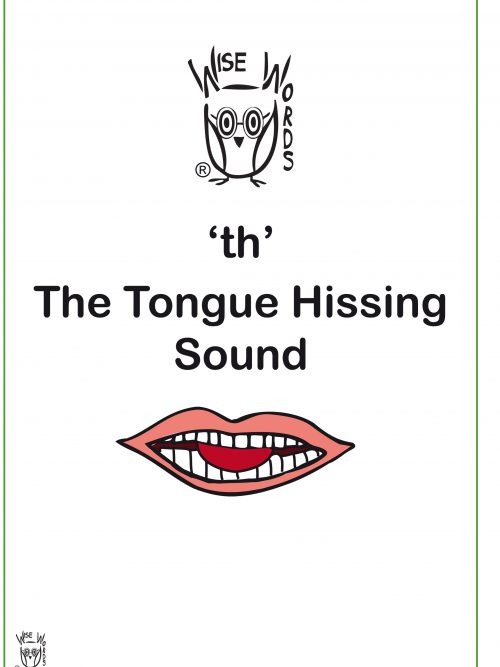 Wise Words Articulation Programs support clinicians, teachers and parents to establish 'new' (correct) sounds into their child's speech. Each program supplies detailed instructions for every task and game. The instructions have been written in a clear manner for a non-professional to follow. Numerous games are provided. These games have been designed to be fun and interactive and will ensure that the child remains engaged and compliant. Playing the games will help the child to generalise the ‘new’ sound into their everyday speech.
Wise Words Articulation Programs support clinicians, teachers and parents to establish 'new' (correct) sounds into their child's speech. Each program supplies detailed instructions for every task and game. The instructions have been written in a clear manner for a non-professional to follow. Numerous games are provided. These games have been designed to be fun and interactive and will ensure that the child remains engaged and compliant. Playing the games will help the child to generalise the ‘new’ sound into their everyday speech. -
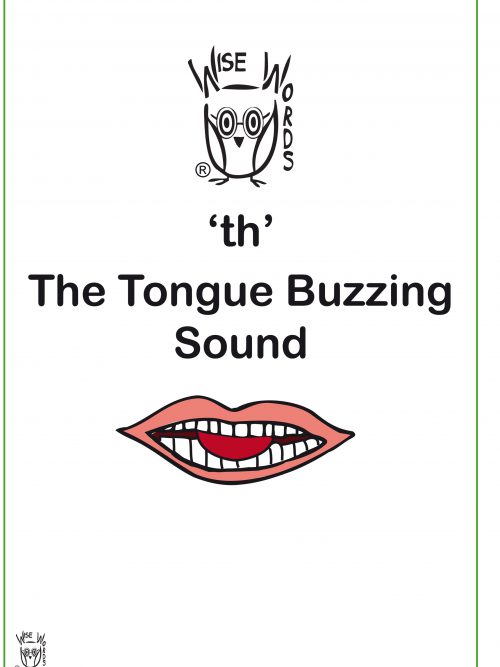 Wise Words Articulation Programs support clinicians, teachers and parents to establish 'new' (correct) sounds into their child's speech. Each program supplies detailed instructions for every task and game. The instructions have been written in a clear manner for a non-professional to follow. Numerous games are provided. These games have been designed to be fun and interactive and will ensure that the child remains engaged and compliant. Playing the games will help the child to generalise the ‘new’ sound into their everyday speech.
Wise Words Articulation Programs support clinicians, teachers and parents to establish 'new' (correct) sounds into their child's speech. Each program supplies detailed instructions for every task and game. The instructions have been written in a clear manner for a non-professional to follow. Numerous games are provided. These games have been designed to be fun and interactive and will ensure that the child remains engaged and compliant. Playing the games will help the child to generalise the ‘new’ sound into their everyday speech. -
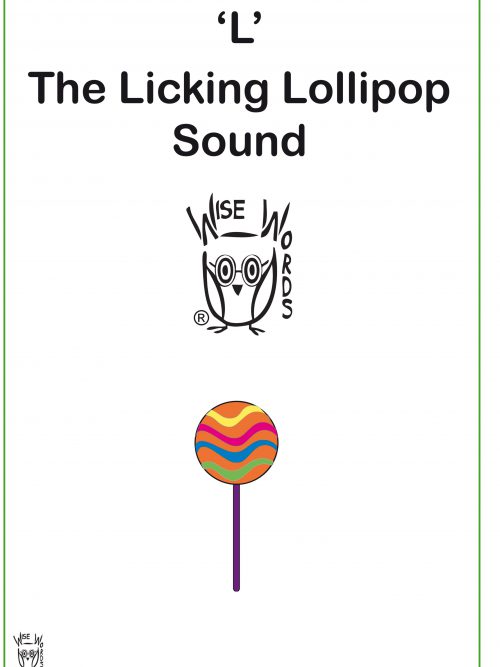 Wise Words Articulation Programs - support clinicians, teachers and parents to establish 'new' (correct) sounds into their child's speech. Each program supplies detailed instructions for every task and game. The instructions have been written in a clear manner for a non-professional to follow. Numerous games are provided. These games have been designed to be fun and interactive and will ensure that the child remains engaged and compliant. Playing the games will help the child to generalise the ‘new’ sound into their everyday speech.
Wise Words Articulation Programs - support clinicians, teachers and parents to establish 'new' (correct) sounds into their child's speech. Each program supplies detailed instructions for every task and game. The instructions have been written in a clear manner for a non-professional to follow. Numerous games are provided. These games have been designed to be fun and interactive and will ensure that the child remains engaged and compliant. Playing the games will help the child to generalise the ‘new’ sound into their everyday speech. -
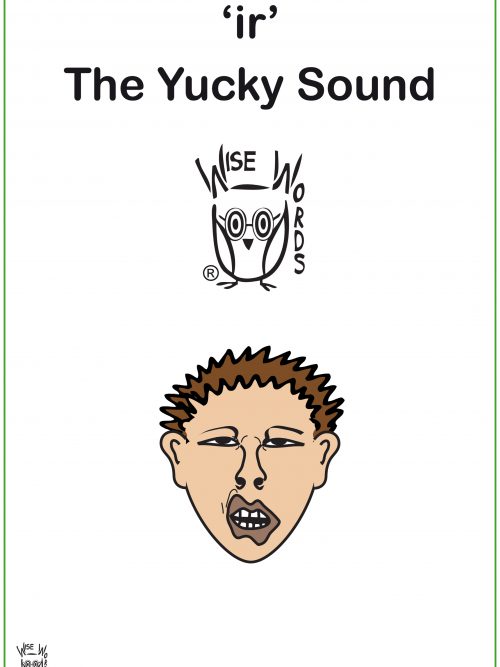
'The Yucky Sound'
Wise Words Articulation Programs support clinicians, teachers and parents to establish 'new' (correct) sounds into their child's speech. Each program supplies detailed instructions for every task and game. The instructions have been written in a clear manner for a non-professional to follow. Numerous games are provided. These games have been designed to be fun and interactive and will ensure that the child remains engaged and compliant. Playing the games will help the child to generalise the ‘new’ sound into their everyday speech. -
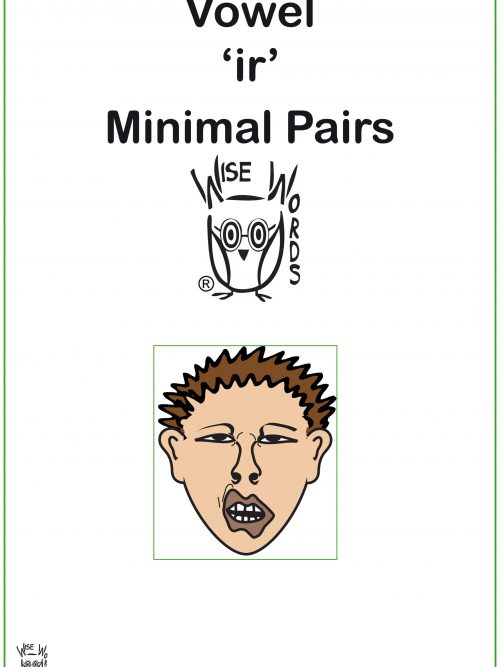
Vowel 'ir' Minimal Pairs
Using Contrastive Pairs This program uses the contrastive phonological approach of Minimal Pairs. The use of minimal pairs is supported by evidence based practice and has been shown to be an effective and efficient treatment for contrasting vowels or consonants. The minimal pair approach - Although many children progress quickly through a vowel articulation program, some children respond more quickly using a phonological approach. The minimal pair approach involves single contrastive pairings of the child’s error with the target sound. In this program the vowel ‘ir’ is contrasted with ‘or’ which most typically replaces ‘ir’. As vocabulary restrictions prevent minimal pair practice at the CV (consonant-vowel) or VC (vowel-consonant) level, it is necessary to use CVC (consonant-vowel-consonant) words as minimal pairs. It is recommended that some ‘ir’ words are not targeted in practice. This group of words should be retained as a probe for generalisation. -
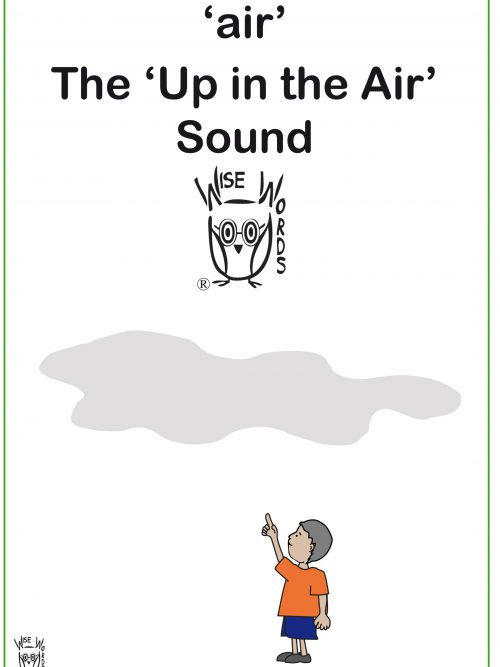
The 'Up in the Air' sound
Wise Words Articulation Programs - support clinicians, teachers and parents to establish 'new' (correct) sounds into their child's speech. Each program supplies detailed instructions for every task and game. The instructions have been written in a clear manner for a non-professional to follow. Numerous games are provided. These games have been designed to be fun and interactive and will ensure that the child remains engaged and compliant. Playing the games will help the child to generalise the ‘new’ sound into their everyday speech.
